Yokogawa UP550 User Manual
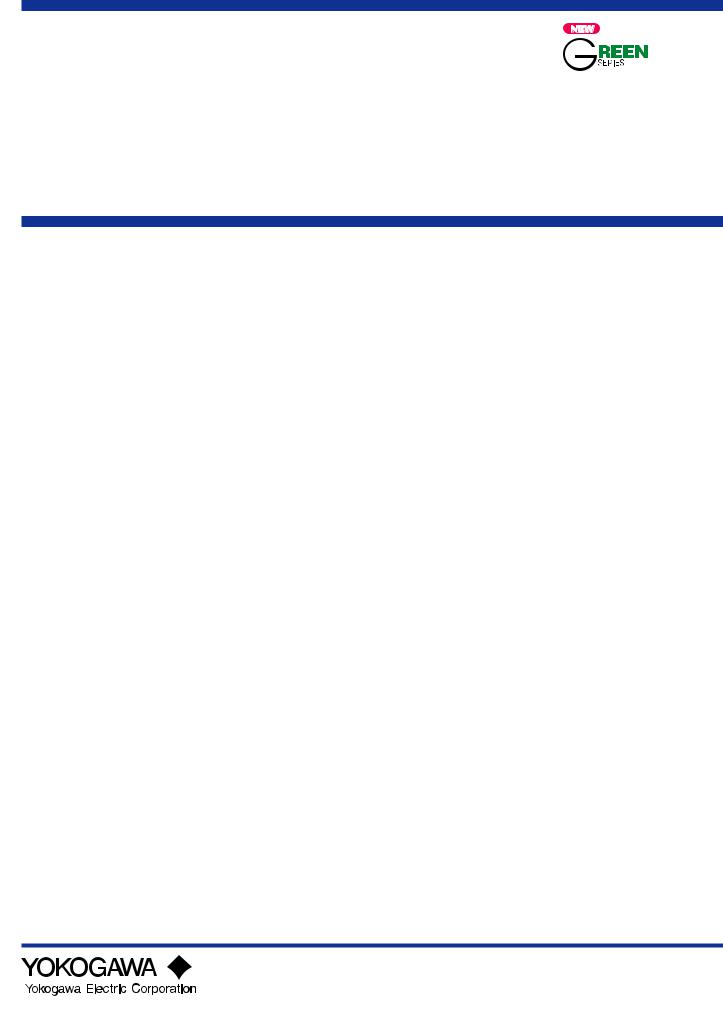
User’s Manual Model UP550
Program Controller
User’s Manual for
Loop Control with PV Switching
IM 05E01C02-46E
IM 05E01C02-46E
3rd Edition

Blank Page

<Toc> <Rev> |
i |
Introduction
Thank you for purchasing the UP550 program controller.
■ How to Use the Manuals
Purpose |
|
Title |
Description |
|
|
|
|
Setup |
1. |
Installation |
Describes the tasks (installation, wiring, and others) |
|
|
|
required to make the controller ready for operations. |
|
|
|
|
Basic operation |
2. Initial Settings |
Describes examples of setting PV input types and |
|
|
|
|
control output types. Making settings described herein |
|
|
|
and program creation in “3. Programming” allows you to |
|
|
|
carry out basic control. |
Program creation |
3. |
Programming |
Describes examples of creating basic programs. The |
|
|
|
use of the program pattern setup charts included in the |
|
|
|
“3.7 Program Pattern Setup Charts” is recommended. |
|
|
|
|
General understand- |
3.5 Program Parameter Map |
Contains a parameter map that serves as a guide to |
|
ing of programming |
3.6 Lists of Program Parameters |
creating programs. Also includes a brief explanation |
|
operations |
|
|
of the functions of program parameters. |
Operating |
4. |
Operations |
Describes key operation sequences. For operation |
procedures |
|
|
control through external contact inputs, see |
and troubleshooting |
|
|
“1.5 Terminal Wiring Diagrams”. |
|
|
|
|
Brief operation |
6.1 |
Parameter Map |
Contains the parameter map used as a guideline for |
|
|
|
setting parameters. |
Function description |
6.2 |
Lists of Parameters |
Briefly describes the functions of parameters. In addition, |
and setpoint |
|
|
each parameter table has a User Setting column, where |
recording |
|
|
you can record your setpoints when setting them in the |
|
|
|
controller. |
|
|
|
|
■ Controllers Applicable to Loop Control with PV Switching
The specification codes of the UP550 applicable to loop control with PV switching are given in the table below.
UP550-01 |
UP550-11 |
UP550-21 |
|
|
|
■Regarding This User’s Manual
(1)This manual should be provided to the end user. Keep an extra copy or copies of the manual in a safe place.
(2)Read this manual carefully to gain a thorough understanding of how to operate this product before starting operation.
(3)This manual describes the functions of this product. Yokogawa Electric Corporation (hereinafter simply referred to as Yokogawa) does not guarantee the application of these functions for any particular purpose.
(4)Under absolutely no circumstances may the contents of this manual, in part or in whole, be transcribed or copied without permission.
(5)The contents of this manual are subject to change without prior notice.
(6)Every effort has been made to ensure that the details of this manual are accurate. However, should any errors be found or important information be omitted, please contact your nearest Yokogawa representative or our sales office.
Media No. IM 05E01C02-46E (CD) |
3rd Edition : May 2006 (YK) |
IM 05E01C02-46E 3rd Edition: May 31, 2006-00 |
All Rights Reserved Copyright © 2000, Yokogawa Electric Corporation |
|
|
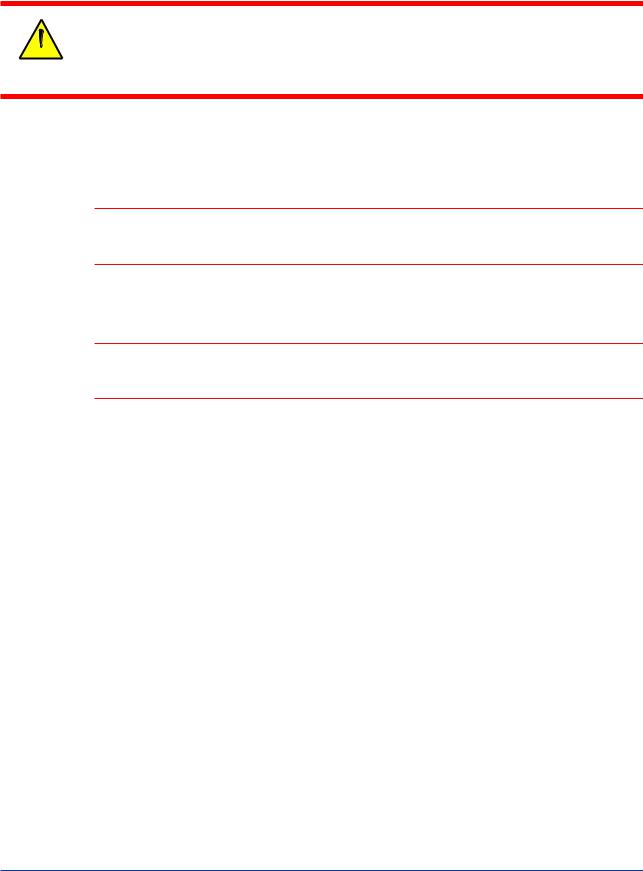
<Toc> <Rev> |
ii |
■ Safety Precautions
The following symbol is indicated on the controller to ensure safe use.
This symbol on the controller indicates that the operator must refer to an explanation in the user’s manual in order to avoid the risk of injury or death of personnel or damage to the
 instrument. The manual describes how the operator should exercise special care to avoid CAUTION electric shock or other dangers that may result in injury or loss of life.
instrument. The manual describes how the operator should exercise special care to avoid CAUTION electric shock or other dangers that may result in injury or loss of life.
The following symbols are used in the hardcopy user’s manuals and in the user’s manual supplied on the CD-ROM.
 NOTE
NOTE
Indicates that operating the hardware or software in a particular manner may damage it or result in a system failure.
 IMPORTANT
IMPORTANT
Draws attention to information that is essential for understanding the operation and/or features of the controller.
■Force Majeure
(1)Yokogawa assumes no liability to any party for any loss or damage, direct or indirect, caused by the use or any unpredictable defect of the product.
(2)No portion of the software supplied by Yokogawa may be transferred, exchanged, leased or sublet for use by any third party without the prior permission of Yokogawa.
(3)Be sure to use the spare parts approved by Yokogawa when replacing parts or consumables.
(4)Use this software with one specified computer only. You must purchase another copy of the software for use on each additional computer.
(5)Copying this software for purposes other than backup is strictly prohibited.
(6)Store the floppy disk(s) (original medium or media) containing this software in a secure place.
IM 05E01C02-46E 3rd Edition: May 31, 2006-00

<Toc> <Rev> |
iii |
■Regarding Protection, Safety, and Prohibition Against Unauthorized Modification
(1)In order to protect the product and the system controlled by it against damage and ensure its safe use, make certain that all of the instructions and precautions relating to safety contained in this document are strictly adhered to. Yokogawa does not guarantee safety if products are not handled according to these instructions.
(2)Modification of the product is strictly prohibited.
(3)Reverse engineering such as the disassembly or decompilation of software is strictly prohibited.
IM 05E01C02-46E 3rd Edition: May 31, 2006-00

Blank Page

<Int> <Rev> |
Toc-i |
Model UP550 Program Controller
User’s Manual for Loop Control with PV Switching
|
|
IM 05E01C02 - 46E 3rd Edition |
CONTENTS |
|
|
Introduction |
i |
|
1. |
Installation .............................................................................................. |
1-1 |
|
1.1 .................................................................................. |
1-1 |
|
1.2 ................................................................................................... |
1-2 |
|
1.3 .................................................................................... |
1-5 |
|
1.4 ................................................................................ |
1-7 |
|
1.5 ............................................................................ |
1-13 |
2. |
Initial Settings ......................................................................................... |
2-1 |
|
2.1 ................................................... |
2-2 |
|
2.2 ................................................. |
2-3 |
|
2.3 ......................................................................................... |
2-4 |
|
2.4 ....................................................... |
2-5 |
|
2.5 .............................................................. |
2-10 |
|
2.6 .. |
2-12 |
|
2.7 .. |
2-14 |
|
2.8 .................................................................................. |
2-16 |
|
2.9 ..................................................................... |
2-18 |
|
2.10 ............................................................... |
2-19 |
3. |
Programming .......................................................................................... |
3-1 |
|
3.1 ....................................................................... |
3-1 |
|
3.2 ................................................... |
3-2 |
|
3.3 ............................................................................. |
3-4 |
|
3.4 .......................................................................... |
3-11 |
|
3.5 ............................................................................... |
3-14 |
|
3.6 ....................................................................... |
3-16 |
|
3.7 ..................................................................... |
3-21 |
|
3.8 .............................................................. |
3-24 |
4. |
Operations .............................................................................................. |
4-1 |
|
4.1 ......... |
4-1 |
|
4.2 ................................................................ |
4-5 |
|
4.3 ....................................................................................... |
4-6 |
|
4.4 .................................................. |
4-8 |
|
4.5 ................................................. |
4-9 |
IM 05E01C02-46E 3rd Edition: May 31, 2006-00

<Int> <Rev> |
|
|
|
Toc-ii |
|
4.6 |
Switching between AUTO and MAN ............................................................. |
4-10 |
|
|
4.7 |
Manipulating Control Output during Manual Operation .............................. |
4-11 |
|
|
4.8 |
Switching Input with Contact Input .............................................................. |
4-13 |
|
|
4.9 |
Enabling/Disabling Hold Mode of Program Operation ............................... |
4-14 |
|
|
4.10 |
Changing Program Setpoints when in Hold Mode ...................................... |
4-15 |
|
|
4.11 |
Executing “Advance” Function ................................................................... |
4-16 |
|
|
4.12 |
Switching to Local-mode (LOCAL) Operation ............................................. |
4-17 |
|
|
4.13 |
Changing Setpoints during Local-mode Operation .................................... |
4-18 |
|
5. |
Troubleshooting and Maintenance ........................................................ |
5-1 |
||
|
5.1 |
Troubleshooting .............................................................................................. |
5-1 |
|
|
5.2 |
Maintenance .................................................................................................... |
5-6 |
|
|
|
5.2.1 |
Cleaning ........................................................................................... |
5-6 |
|
|
5.2.2 |
Replacing Brackets ........................................................................... |
5-6 |
|
|
5.2.3 |
Attaching Terminal Cover .................................................................. |
5-7 |
|
|
5.2.4 |
Replacing Parts with a Limited Service Life ....................................... |
5-8 |
|
|
5.2.5 |
Replacing Control Output Relays ...................................................... |
5-9 |
6. |
Parameters .............................................................................................. |
|
6-1 |
|
|
6.1 |
Parameter Map ................................................................................................ |
6-1 |
|
|
6.2 |
Lists of Parameters ......................................................................................... |
6-6 |
|
7. |
Function Block Diagram and Descriptions............................................ |
7-1 |
||
Revision Information ............................................................................................ |
|
i |
||
IM 05E01C02-46E 3rd Edition: May 31, 2006-00

<Toc> |
<1. Installation> |
1-1 |
1.Installation
This chapter describes installation, wiring, and other tasks required to make the controller ready for operation.
1.1Model and Suffix Codes
Before using the controller, check that the model and suffix codes match your order.
|
Model |
Suffix Code |
Description |
|
|
|
|
|
|
||
UP550 |
|
|
Program controller (provided with retransmission output and 15 V DC loop power supply as standard) |
||
|
|
|
|
|
|
|
|
-0 |
Standard type |
|
|
Type |
|
-1 |
Position proportional type |
|
|
|
|
-2 |
Heating/cooling type |
|
|
|
|
|
|
|
|
Optional functions |
|
0 |
None |
|
|
|
1 |
With communication, auxiliary analog input, and 1 additional DI |
|
||
|
|
|
|
||
|
|
|
|
|
|
Check that the following items are provided: |
|
||||
• Program controller (of ordered model) .................................. |
1 |
||||
• |
Brackets (mounting hardware) ............................................. |
1 pair |
|||
• |
Unit label.............................................................................. |
|
1 |
||
• User’s Manuals for Single-loop Control ................................ |
7 (A2 size) |
||||
• User’s Manual (Reference) (CD-ROM version) .................... |
1 |
||||
■Correspondence between the Model and Suffix Codes, and the Contact Input/Output Terminals Provided
Check the model ordered and the presence/absence of contact inputs and outputs in the following table.
indicate that the contacts are available.
Model and Suffix |
|
|
Contact input terminals |
|
|
|
|
Contact output terminals |
|
|
||||||||
Codes |
|
DI1 |
DI2 |
DI3 |
DI4 |
DI5 |
DI6 |
DI7 |
DI8 |
DO1 |
DO2 |
|
DO3 |
DO4 |
DO5 |
|
DO6 |
DO7 |
|
|
|
|
|
|
|
|
|
|
|
|
|
|
|
|
|
|
|
UP550- |
0 |
|
|
|
|
|
|
|
|
|
|
|
|
|
|
|
|
|
|
|
|
|
|
|
|
|
|
|
|
|
|
|
|
|
|
|
|
UP550- |
1 |
|
|
|
|
|
|
|
|
|
|
|
|
|
|
|
|
|
|
|
|
|
|
|
|
|
|
|
|
|
|
|
|
|
|
|
|
Note: For details on the functions of contact inputs/outputs, see “1.5 Terminal Wiring Diagrams.”
IM 05E01C02-46E 3rd Edition: May 31, 2006-00
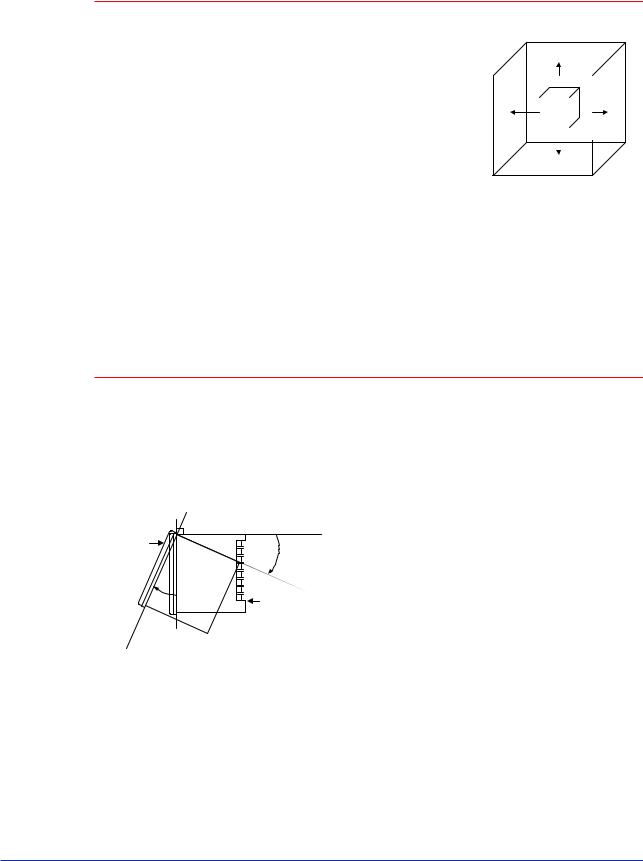
<Toc> |
<1. Installation> |
1-2 |
1.2How to Install
 NOTE
NOTE
To install the controller, select a location where:
1.no one may accidentally touch the terminals,
2. mechanical vibrations are minimal,
|
|
|
|
|
|
|
|
|
|
|
|
|
|
3. |
corrosive gas is minimal, |
|
|
150mm |
|
|
|
|
|
|
|
||
|
|
|
|
|
|
|
|
|
|
|
|
||
|
|
|
|
|
|
|
|
|
|
|
|
||
4. |
temperature can be maintained at about 23 C and |
|
|
|
|
|
|
|
|
|
|
|
|
|
|
|
|
|
|
|
|
|
|
|
|
||
|
the fluctuation is minimal, |
|
150mm |
|
|
|
|
|
|
|
150mm |
||
|
|
|
|
|
|
|
|
|
|
|
|
|
|
|
|
|
|
|
|
|
|
150mm |
|
||||
|
|
|
|
|
|
|
|
|
|
||||
5. |
no direct radiant heat is present, |
|
|
|
|
|
|
|
|
|
|
|
|
|
|
|
|
|
|
|
|
|
|
|
|
||
6.no magnetic disturbances are caused,
7.no wind blows against the terminal board (reference junction compensation element),
8.no water is splashed,
9.no flammable materials are around,
Never place the controller directly on flammable items or equipment.
If the controller has to be installed close to flammable items or equipment, be sure to provide shielding panels all around the controller, at least 150 mm away from every side; the panels should be made of either 1.43 mm-thick metal-plated steel plates or 1.6 mmthick uncoated steel plates.
● Installation Position
Install the controller at an angle within 30 from horizontal with the front panel facing upward. Do not install it facing downward. The position of right and left sides should be horizontal.
Front panel
of controller Must not exceed 30
30 |
Rear of |
|
controller |
||
|
IM 05E01C02-46E 3rd Edition: May 31, 2006-00

<Toc> |
<1. Installation> |
1-3 |
■ External Dimensions and Panel Cutout Dimensions |
|
|
UP550 |
Unit: mm |
|
96 |
11 |
100 |
Large bracket |
PVE1
PVE2
96 |
91.8 |
112 |
|
|
Small bracket |
|
1 to 10 mm (Panel thickness) |
|
General installation |
Side-by-side close installation |
|
|
117 min. |
[(N-1) 96+92]+00.8 |
|
+0.8 |
0 |
|
92 |
|
(53) |
145 min. |
|
|
“N” stands for the number of controllers to be |
|
|
|
|
|
|
installed. |
92+00.8 |
|
However, the measured value applies if N 5. |
92+00.8 |
(25) |
|
IM 05E01C02-46E 3rd Edition: May 31, 2006-00
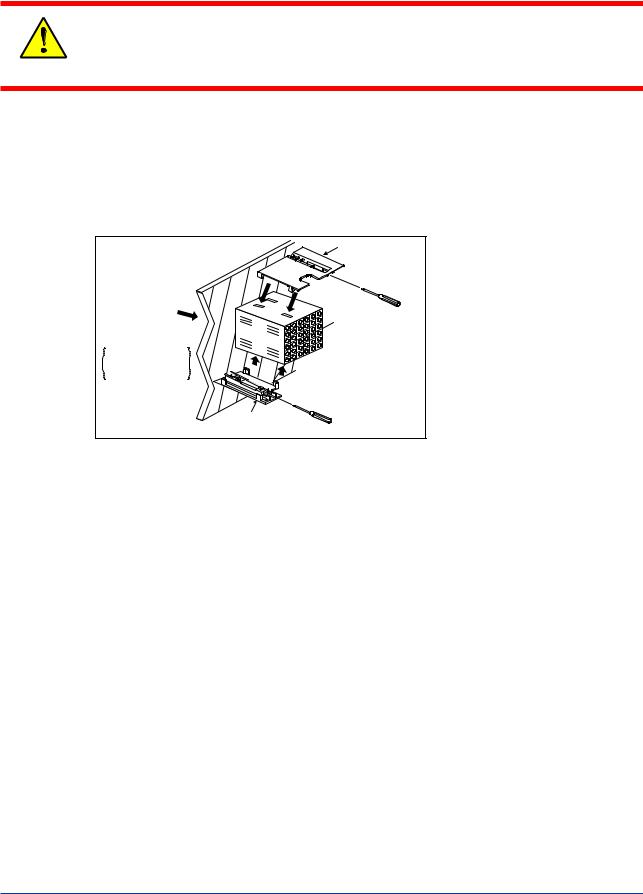
<Toc> |
<1. Installation> |
1-4 |
■ How to Install
Turn off the power to the controller before installing it on the panel because there is a possibility of electric shock.
CAUTION
After opening the mounting hole on the panel, follow the procedures below to install the controller:
1.Insert the controller into the opening from the front of the panel so that the terminal board on the rear is at the far side.
2.Set the brackets in place on the top and bottom of the controller as shown in the figure below, then tighten the screws of the brackets. Take care not to overtighten them.
Direction to insert the controller
Insert the controller into the opening at the front of the panel.
Large bracket
Panel |
(top mounting hardware) |
Terminal board |
|
Insert a screwdriver into the |
|
brackets to tighten the screws. |
|
Small bracket |
Recommended |
tightening torque |
|
(bottom mounting hardware) |
:0.4N m |
IM 05E01C02-46E 3rd Edition: May 31, 2006-00

<Toc> |
<1. Installation> |
1-5 |
1.3How to Connect Wires
1)Before carrying out wiring, turn off the power to the controller and check that the
cables to be connected are not alive with a tester or the like because there is a possibility of electric shock.
CAUTION 2) For the protection and safe use of the controller, be sure to place a circuit breaker (conforms with IEC60947, 5A, 100V or 220V AC) near the controller where the breaker can easily be operated. In addition, be sure to indicated that it is the instrument to cut the power supply of the controller.
3)Wiring must be carried out by personnel who have basic electrical knowledge and practical experience.
 NOTE
NOTE
1)Provide power from a single-phase instrument power supply. If there is a lot of noise in the power line, insert an insulating transformer into the primary side of the line and use a line filter (recommended part: ZAC2205-00U from TDK) on the secondary side.
As a countermeasures against noise, do not place the primary and secondary power cables close to each other.
2)For thermocouple input, use shielded compensating lead wires for wiring. For RTD input, use shielded wires that have low conductor resistance and cause no significant differences in resistance between the three wires.
The cables to be used for wiring, terminal specifications, and recommended parts are as shown below.
3)Control output relays may be replaced. However, because they have a life of 100,000 times that of the resistance load, use auxiliary relays to turn on/off a load.
4)The use of inductance (L) loads such as auxiliary relays, motors and solenoid valves causes malfunction or relay failure; always insert a CR filter for use with alternating current or a diode for use with direct current, as a spark-removal surge suppression circuit, into the line in parallel with the load.
5)When there is a possibility of being struck by external lightning surge, use the arrester to protect the instrument.
■ For DC Relay Wiring |
■ For AC Relay Wiring |
UP550 |
External DC power supply |
||
|
|
||
O.C Relay |
|
||
|
|
|
|
|
|
R |
|
|
|
Diode |
|
UP’s contact |
|
(Mount it directly |
|
Relay |
to the relay coil |
||
|
|||
(Use one with a relay coil |
terminal (socket).) |
||
rating less than the UP’s |
|
||
|
contact rating.) |
|
|
UP550  External AC power supply
External AC power supply
|
|
R |
UP’s contact |
Relay |
CR filter |
|
||
(Use one with a relay coil |
(Mount it directly |
|
rating less than the UP’s |
to the relay coil |
|
|
contact rating.) |
terminal (socket).) |
IM 05E01C02-46E 3rd Edition: May 31, 2006-00
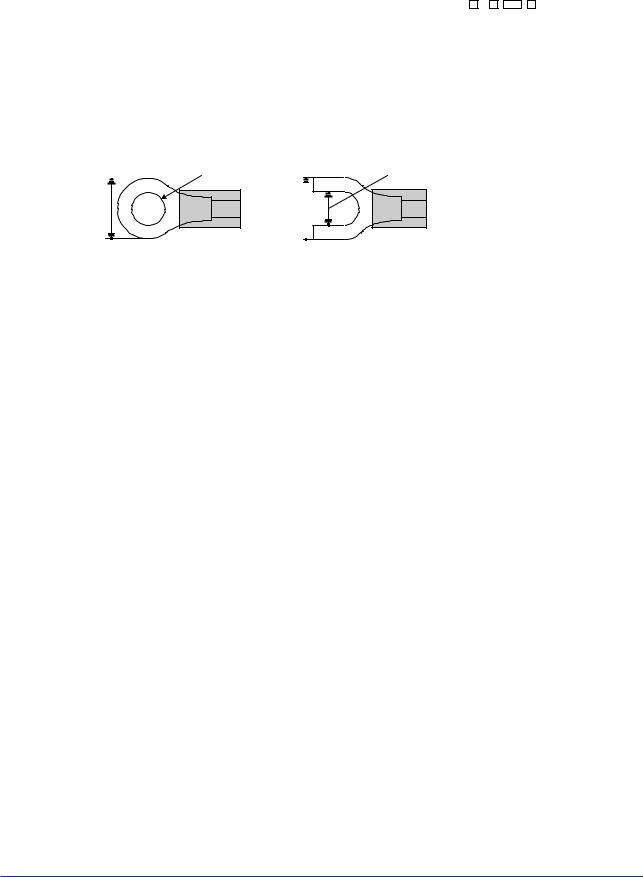
<Toc> |
|
|
|
|
|
<1. Installation> |
1-6 |
|||||||||||
● Cable Specifications and Recommended Cables |
|
|||||||||||||||||
|
|
|
|
|
|
|
|
|
|
|
|
|
|
|
|
|
|
|
|
|
|
Purpose |
|
|
|
|
Name and Manufacturer |
|
|||||||||
|
|
|
|
|
|
|
|
|
|
|
|
|
|
|
|
|
|
|
|
Power supply, grounding, relay contact outputs |
600 V PVC insulated wires, JIS C 3307, 0.9 to 2.0 mm2 |
|
|||||||||||||||
|
Thermocouple |
|
|
Shielded compensating lead wires, JIS C 1610, |
|
X- |
|
- |
|
- |
|
|
|
|||||
|
|
|
|
|
|
|
|
|||||||||||
|
|
|
|
|
|
|
|
|||||||||||
|
|
|
|
|
|
(See Yokogawa Electric’s GS 6B1U1-E.) |
|
|||||||||||
|
|
|
|
|
|
|
|
|
|
|
|
|
|
|
|
|
|
|
|
RTD |
|
|
Shielded wires (three conductors), UL2482 (Hitachi Cable) |
|
|||||||||||||
|
|
|
|
|
|
|
|
|
|
|
|
|
|
|
|
|
|
|
|
Other signals |
|
|
Shielded wires |
|
|||||||||||||
|
|
|
|
|
|
|
|
|
|
|
|
|
|
|
|
|
|
|
● Recommended Terminal Lugs |
|
|||||||||||||||||
|
|
|
|
|
|
|
|
|
||||||||||
|
|
Applicable wire size |
|
Tightening torque |
|
|
|
|
|
|
|
|
|
|
||||
|
|
|
|
|
|
|
|
|||||||||||
|
0.3 to 1.65 mm2 |
|
0.8 N·m or less |
|
|
|
|
|
|
|
|
|
|
|||||
|
|
|
|
|
|
|
|
|
|
|
||||||||
|
|
|
|
3 . 7 m m |
|
|
3 . 7 m m |
|
||||||||||
|
|
|
|
|
|
|
|
|
|
|
|
|
|
|
|
|
|
|
7 m m o r l e s s
or
7 m m o r l e s s
● Terminal Covers
Target Model |
Part Number |
Sales Unit |
|
|
|
For UP550 |
T9115YD |
1 |
|
|
|
IM 05E01C02-46E 3rd Edition: May 31, 2006-00

<Toc> |
<1. Installation> |
1-7 |
1.4Hardware Specifications
PV Input Signals (PV Input 1)
•Number of inputs: 1 (terminals 11 - 12 - 13 )
•Input type: Universal input system. The input type can be selected with the software.
•Sampling period: Can be selected from 100, 200 and 500 ms. Initial value: 200 ms
•Burnout detection: Functions at TC, RTD, standard signal (0.4 to 2 V or 1 to 5 V) Upscale, downscale, and off can be specified.
For standard signal, burnout is determined to have occurred if it is 0.1 V or less.
•Input bias current: 0.05 A (for TC or RTD b-terminal)
•Measurement current (RTD): About 0.13 mA
•Input resistance: 1 M or more for thermocouple or mV input About 1 M for DC voltage input
•Allowable signal source resistance: 250 or less for thermocouple or mV input Effects of signal source resistance: 0.1 V/ or less
2 k or less for DC voltage input
Effects of signal source resistance: About 0.01%/100
•Allowable wiring resistance: for RTD input
Maximum 150 /wire: Conductor resistance between three wires should be equal However, 10 /wire for a maximum range of -150.0 to 150.0 C.
Wire resistance effect: 0.1 C/10
•Allowable input voltage: 10 V DC for thermocouple, mV, or RTD input20 V DC for DC voltage input
•Noise rejection ratio: 40 dB (50/60 Hz) or more in normal mode 120 dB (50/60 Hz) or more in common mode
•Reference junction compensation error: 1.0 C (15 to 35 C)1.5 C (0 to 15 C, 35 to 50 C)
•Applicable standards: JIS, IEC, DIN (ITS-90) for thermocouples and RTD
Auxiliary Analog Input Signals (PV Input 2)
Available only for controllers with auxiliary analog input terminals.
•Number of inputs: 1 (terminals 21 - 22 )
•Input type: Settable in a range of 0-2, 0-10, 0.4-2.0, or 1-5 V DC
•Sampling period: 100, 200 and 500 ms
The sampling period of an auxiliary analog input signal is associated with the PV input’s sampling period.
•Input resistance: About 1 M
•Input accuracy: 0.3% 1 digit of input span for 0 to 2 V DC0.2% 1 digit of input span for 0 to 10 V DC
0.375% 1 digit of input span for 0.4 to 2.0 V DC0.3% 1 digit of input span for 1 to 5 V DC
Under standard operating conditions (23 2 C, 55 10% RH, power frequency of 50/ 60 Hz)
IM 05E01C02-46E 3rd Edition: May 31, 2006-00
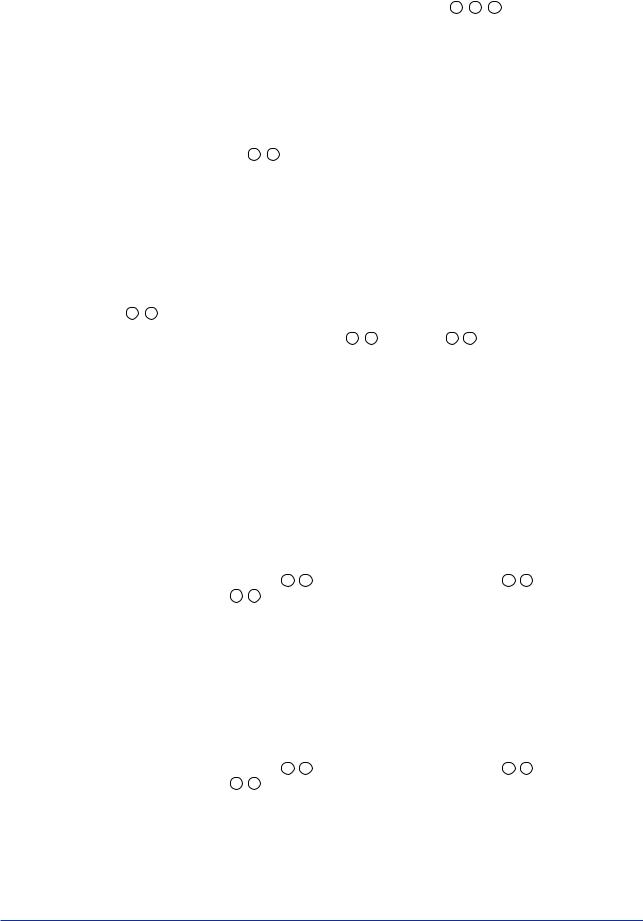
<Toc> |
<1. Installation> |
1-8 |
Feedback Resistance Input
Provided for position proportional type only (terminals 45 - 46 - 47 )
•Slide resistance value: 100 to 2.5 k of overall resistance (burnout detection for sliding wire provided)
•Measuring resolution: 0.1% of overall resistance
Loop Power Supply
Power is supplied to a two-wire transmitter. (15 V DC: terminals 14 - 15 )
A resistor (10 to 250 ) connected between the controller and transmitter converts a current signal into a voltage signal, which is then read via the PV input terminal. Supply voltage: 14.5 to 18.0 V DC, max. 21 mA (provided with a protection circuit against a field short-circuit)
Retransmission Output
Either PV, program setpoint, or control output is output.
Either the retransmission output or the loop power supply can be used with terminals
14- 15 .
•Number of outputs: 1 or 2 (terminals 14 - 15 , terminals 16 - 17 )
•Output signal: 4-20, 0-20, 20-4, or 20-0 mA DC (where, outputting signal levels of less than 0 mA is not feasible)
•Load resistance: 600 or less
•Output accuracy: 0.1% of span ( 5% of span for 1 mA or less.)
Under standard operating conditions (23 2 C, 55 10% RH, power frequency of 50/ 60 Hz)
Control Output
Universal output system, The output type can be selected with the software.
Relay contact output(s) for the position proportional type.
•Current output
(Standard type: terminals 16 - 17 ; heating-side output: terminals 16 - 17 , cooling-side output: terminals 46 - 47 )
Number of outputs |
1 or 2 (two for heating/cooling type), |
|
switched between a voltage pulse output |
|
and current output. |
|
|
Output signal |
4-20, 0-20, 20-4, or 20-0 mA DC |
|
|
Load resistance |
600 or less |
|
|
Output accuracy |
0.1% of span |
|
( 5% of span for 1 mA or less) |
|
Under standard operating conditions (23 2 C, |
|
55 10% RH, power frequency of 50/60 Hz) |
|
|
•Voltage pulse output
(Standard type: terminals 16 - 17 ; heating-side output: terminals 16 - 17 , cooling-side output: terminals 46 - 47 )
Number of |
1 or 2 (two for heating/cooling type), |
outputs |
switched between a voltage pulse output and current output. |
|
|
Output signal |
On-voltage = 12 V or more (load resistance: 600 or more) |
|
Off-voltage = 0.1 V DC or less |
|
|
Resolution |
10 ms or 0.1% of output, whichever is larger |
|
|
IM 05E01C02-46E 3rd Edition: May 31, 2006-00

<Toc> |
<1. Installation> |
1-9 |
•Relay contact output
(Standard type: terminals 1 - 2 - 3 , heating-side output: terminals 1 - 2 - 3 , coolingside output: terminals 48 - 49 - 50 , position proportional type: terminals 48 - 49 - 50 )
Number of outputs |
1 or 2 (two for heating/cooling type) |
|
|
Output signal |
Three terminals (NC, NO, and common) |
|
|
Contact rating |
250 V AC or 30 V DC, 3 A (resistance load) |
|
|
Resolution |
10 ms or 0.1% of output, whichever is larger |
|
|
Contact Inputs
• Purpose: Program pattern no. selection, and run/reset switching
• Number of inputs: Differs with model and suffix codes as shown in the table below.
Model and Suffix Codes |
Number of Inputs |
|
|
|
|
UP550- |
0 |
7 |
|
|
|
UP550- |
1 |
8 |
|
|
|
• Input type: Non-voltage contact or transistor open collector input
• Input contact rating: 12 V DC, 10 mA or more
• On/off determination: For non-voltage contact input, contact resistance of 1 k or less is determined as “on” and contact resistance of 20 k or more as “off.”
For transistor open collector input, input voltage of 2 V or less is determined as “on” and leakage current must not exceed 100 A when “off.”
• Minimum status detection hold time: PV input’s sampling period 3
Contact Outputs
•Purpose: Event output, FAIL output, and others
•Number of outputs: 7 points
•Relay contact rating: 240 V AC, 1 A, or 30 V DC, 1 A
•Transistor contact rating: 24 V DC, 50 mA
Display Specifications
•PV display: 5-digit, 7-segment, red LEDs, character height of 20 mm
•Setpoint display: 32 128 dot LCD with back lighting
•Status indicating lamps: LEDs
IM 05E01C02-46E 3rd Edition: May 31, 2006-00

<Toc> |
<1. Installation> |
1-10 |
Safety and EMC Standards
•Safety: Complies with IEC/EN61010-1 (CE), approved by C22.2 No.61010-1, approved by UL508.
Installation category : CAT. II Pollution degree : 2 (IEC/EN61010-1, C22.2 No.61010- 1)
Measurement category : I (CAT. I : IEC/EN61010-1)
Rated measurement input voltage : 10V DC max.(across terminals), 300V AC max.(across ground)
Rated transient overvoltage : 1500V (Note)
Note : It is a value on the safety standard which is assumed by IEC/EN61010-1 in Measurement category I, and is not the value which guarantees an apparatus performance.
This equipment has Measurement category I, therefore do not use the equipment for measurements within Measurement categories II, III and IV.
CAUTION
Measurement category |
Description |
Remarks |
|
|
|
|
|
1 |
CAT.1 |
For measurements performed on circuits not directly connected to MAINS. |
|
|
|
|
|
2 |
CAT.2 |
For measurements performed on circuits directly connected to the low voltage installation. |
Appliances, portable equipments, etc. |
3 |
CAT.3 |
For measurements performed in the building installation. |
Distribution board, circuit breaker, etc. |
4 |
CAT.4 |
For measurements performed at the source of the low-voltage installation. |
Overhead wire, cable systems, etc. |
Internal Wiring |
2 |
|
3 |
T |
|
Entrance 4 |
1 |
|
Cable |
|
|
|
|
|
Outlet |
|
|
•EMC standards: Complies with EN61326, EN61000-3-2, EN61000-3-3 and EN55011 (CE).
AS/NZS 2064 compliant (C-Tick). Class A Group 1.
The instrument continues to operate at a measuring accuracy of within 20% of the range during tests.
Construction, Installation, and Wiring
•Construction: Dust-proof and drip-proof pront panel conforming to IP55. For side-by- side close installation the controller loses its dust-proof and drip-proof protection.
•Material: ABS resin and polycarbonate
•Case color: Black
•Weight: About 1 kg or less
•Dimensions: 96 (W) 96 (H) 100 (depth from panel face) mm
•Installation: Panel-mounting type. With top and bottom mounting hardware (1 each)
•Panel cutout dimensions: 920+0.8 (W) 920+0.8 (H) mm
IM 05E01C02-46E 3rd Edition: May 31, 2006-00

<Toc> |
<1. Installation> |
1-11 |
•Installation position: Up to 30° upward facing (not designed for facing downward)
•Wiring: M3.5 screw terminals (for signal wiring and power/ground wiring as well)
Power Supply Specifications
•Power supply: Rated voltage of 100 to 240 V AC ( 10%), 50/60 Hz
•Power consumption: Max. 20 VA (8.0 W max.)
•Internal fuse rating: 250 V AC, 1.6A time-lug fuse
•Data backup: Lithium battery with life expectancy of 10 years
•Withstanding voltage
-Between primary terminals* and secondary terminals**: At least 1500 V AC for 1 minute
-Between primary terminals* and grounding terminal: At least 1500 V AC for 1 minute
-Between grounding terminal and secondary terminals**: At least 1500 V AC for 1 minute
-Between secondary terminals**: At least 500 V AC for 1 minute
*Primary terminals indicate power terminals and relay output terminals
**Secondary terminals indicate analog I/O signal, voltage pulse output, and contact input terminals
•Insulation resistance: 20 M or more at 500 V DC between power terminals and grounding terminal
•Grounding: Class D grounding (grounding resistance of 100 or less)
Signal Isolations
•PV input (PV input 1) terminals: Isolated from other input/output terminals. Not isolated from the internal circuit.
•Auxiliary analog input (PV input 2) terminals: Isolated from other input/output terminals and the internal circuit
•15 V DC loop power supply terminals: Not isolated from analog current output and voltage pulse control output. Isolated from other input/output terminals and internal circuit.
•Analog current output terminals (for control output and retransmission): Not isolated between current outputs and from 15 V DC loop power supply and voltage pulse control output. Isolated from other input/output terminals and internal circuit.
•Voltage pulse control output terminals: Not isolated from current outputs and 15 V DC loop power supply. Isolated from other input/output terminals and internal circuit.
•Relay contact control output terminals: Isolated between contact output terminals and from other input/output terminals and internal circuit.
•Contact input terminals: Not isolated between contact input terminals and from communication terminals. Isolated from other input/output terminals and internal circuit.
•Relay contact output terminals: Not isolated between relay contact outputs. Isolated from other input/output terminals and internal circuit.
•Transistor contact output terminals: Not isolated between transistor contact outputs. Isolated from other input/output terminals and internal circuit.
IM 05E01C02-46E 3rd Edition: May 31, 2006-00

<Toc> |
<1. Installation> |
1-12 |
•RS-485 communication terminals: Not isolated from contact input terminals. Isolated from other input/output terminals and internal circuit.
•Feedback slide resistance input terminals: Not isolated from analog current output terminals (control, retransmission), 15 V DC loop power supply, and voltage pulse control outputs. Isolated from other input/output terminals and internal circuit.
•Power terminals: Isolated from other input/output terminals and internal circuit.
•Grounding terminals: Isolated from other input/output terminals and internal circuit.
Environmental Conditions
•Normal operating conditions:
Ambient temperature: 0 to 50 C (40 C or less for side-by-side close installation) Temperature change rate: 10 C/h or less
Ambient humidity: 20 to 90% RH (no condensation allowed) Magnetic field: 400 A/m or less
Continuous vibration at 5 to 14 Hz: Full amplitude of 1.2 mm or less Continuous vibration at 14 to 150 Hz: 4.9 m/s2 or less
Short-period vibration: 14.7 m/s2, 15 seconds or less Shock: 147 m/s2 or less, 11 ms
Installation height: Height above sea level of 2000 m or less Warm-up time: 30 minutes or more after power on
•Transportation and storage conditions: Temperature: -25 to 70 C
Temperature change rate: 20 C/h or less Humidity: 5 to 95% RH (no condensation allowed)
•Effects of changes in operating conditions
-Effects from changes in ambient temperature:
-On voltage or thermocouple input, 1 V/ C or 0.01% of F.S./ C, whichever is larger
-On auxiliary analog input, 0.02% of F.S./ C
-On RTD input, 0.05 C/ C (ambient temperature) or less
-On analog output, 0.05% of F.S./ C or less
-Effects from power supply fluctuation (within rated voltage range)
-On analog input, 1 V/10 V or 0.01% of F.S./10 V, whichever is larger
-On analog output, 0.05% of F.S./10 V or less
IM 05E01C02-46E 3rd Edition: May 31, 2006-00

<Toc> |
<1. Installation> |
1-13 |
1.5Terminal Wiring Diagrams
 NOTE
NOTE
Do not use unassigned terminals as relay terminals.
Terminal wiring diagrams are shown on and after the next page.
IM 05E01C02-46E 3rd Edition: May 31, 2006-00
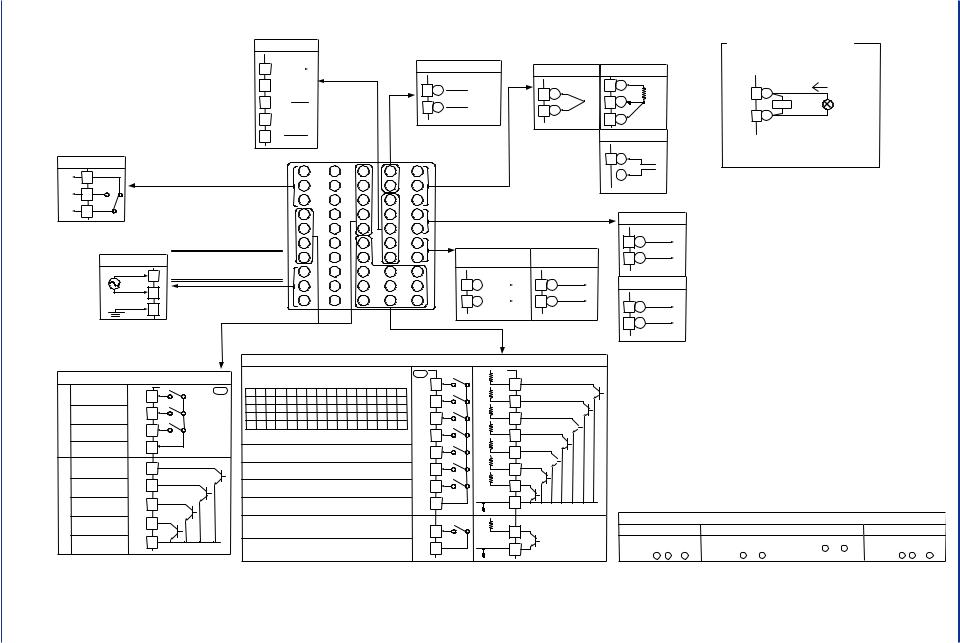
00-2006 31, May Edition: 3rd 46E-05E01C02 IM
■ UP550 Standard Type (Model UP550-0 ), Loop Control with PV Switching |
|
|||||
RS-485 communication |
PV input 2 |
PV input 1 * Not configured at factory before shipment |
Receiving 4-20 mA DC Current |
|||
|
|
* Wiring can only be carried out |
Signals with the Controller |
|||
|
|
for controllers with communication |
|
See "2. Initial Settings". |
||
|
|
|
. |
|||
23 SDB(+) |
|
functions. |
Auxiliary input |
TC input |
RTD input |
* When receiving 4-20 mA DC current signals, |
|
Maximum baud rate: 9600 bps |
set the PV input type to 1-5 V DC (setpoint “41”). |
||||
|
|
|||||
|
|
|
||||
Control output Relay contact output
24
25 26 27
Note: Select this option from the OT1 parameter. *Time proportional PID relay contact
SDA(-) 
RDB(+)
RDA(-) 
SG
21
22
+  -
- 
Specify in a range of 1-5 V DC, 0-2 V DC, or 0-10 V DC.
Default: 1-5 V DC
|
11 |
A |
12 |
+ |
b |
|
12 |
|
13 |
- |
|
|
13 |
B |
|
|
mV/V input |
|
12 |
+ |
12 |
+ |
|
250 Ω 4-20mA |
13 |
- |
Note: Connecting a 250 Ω resistor to the terminals is |
|
optional. |
|
Model: X010-250-2 (resistor with M3.5 crimp-on terminal |
|
lugs) |
|
|
1 |
output is configured at factory |
NC |
before shipment. |
|
|
||
NO |
2 |
|
COM |
3 |
|
Contact rating: 250 V AC, 3 A |
||
|
|
30 V DC, 3 A (resistance load) |
Power supply |
|
Power supply |
|
L |
8 |
|
|
N |
9 |
|
|
|
10 |
 CAUTION
CAUTION
Before carrying out wiring, turn off the power to the controller and check that cables to be connected are not alive with a tester or the like because there is a possibility of electric shock.
1 |
41 |
31 |
21 |
11 |
2 |
42 |
32 |
22 |
12 |
3 |
43 |
33 |
23 |
13 |
4 |
44 |
34 |
24 |
14 |
5 |
45 |
35 |
25 |
15 |
6 |
46 |
36 |
26 |
16 |
7 |
47 |
37 |
27 |
17 |
8 |
48 |
38 |
28 |
18 |
9 |
49 |
39 |
29 |
19 |
10 |
50 |
40 |
30 |
20 |
|
|
|
|
|
|
|
|
13 |
|
|
|
|
Note: Select this option from the OT1 parameter. |
||||
Control output |
* Retransmission output 2 is available |
|||||||
only when “relay” is selected as the |
||||||||
|
|
|
|
type of control output. |
||||
Current/voltage |
Retransmission |
|||||||
|
pulse output |
|
|
output 2* |
||||
|
|
|
|
|
|
Default: Unspecified |
||
|
|
|
|
|
|
retransmission type |
||
16 |
+ |
|
|
|
16 |
+ |
|
|
0-20mADC, |
|
0-20mADC, |
||||||
|
|
4-20mADC |
|
|
|
|||
|
|
|
|
|
4-20mADC |
|||
17 |
- |
Voltage pulse (12 V) |
17 |
- |
||||
|
|
|
|
|
||||
|
|
|
|
|
|
Default: 4-20 mA DC |
||
|
Allowable range: 100-240 V AC ( 10%) |
||
|
|
|
(free voltage) |
|
|
|
50/60 Hz shared |
* The functions of a contact output can be varied by |
|||
changing the setting of the contact output registration |
|||
parameter. |
|
|
|
|
External contact outputs |
||
|
PV event 1 output |
DO1 |
UP |
|
6 |
||
|
|
|
|
Relay |
PV event 2 output |
DO2 |
5 |
Instrument alarm |
DO3 |
4 |
|
|
1 output |
|
|
|
|
|
|
|
Common |
COM |
7 |
|
|
||
Transistor
Time event 1 output
Time event 2 output
Time event 3 output
Time event 4 output
Common
DO4 34 |
|
DO5 |
33 |
|
|
DO6 |
32 |
|
|
DO7 |
31 |
|
|
COM |
35 |
|
|
* The functions of a contact input can be varied by changing the setting of the contact input registration parameter.
|
|
|
|
|
|
|
|
|
|
|
|
|
|
External contact inputs |
||||
Switch between the ON and OFF states of the DI1 to DI4 |
|
UP |
Contact |
|||||||||||||||
contact inputs to select from program pattern numbers |
1 to 15. |
|
||||||||||||||||
DI1 |
19 |
|||||||||||||||||
(Select a number during a RESET state.) |
|
|
|
|
|
|||||||||||||
|
1 |
2 |
3 |
4 |
5 |
6 |
7 |
8 |
9 |
10 |
11 |
12 |
13 |
14 |
15 |
|
|
|
DI1 ON OFF ON OFF ON |
OFF ON OFF ON OFF ON OFF ON |
OFF ON |
DI2 |
18 |
||||||||||||||
DI2 |
OFF ON ON OFF OFF ON ON OFF OFF ON ON OFF OFF ON ON |
|||||||||||||||||
|
|
|||||||||||||||||
DI3 |
OFF OFF OFF ON ON ON ON OFF OFF OFF OFF |
ON ON ON ON |
DI3 |
40 |
||||||||||||||
DI4 |
OFF OFF OFF OFF OFF OFF OFF ON ON ON ON ON ON ON ON |
|||||||||||||||||
|
||||||||||||||||||
|
|
|||||||||||||||||
|
|
|
|
|
|
|
|
|
|
|
|
|
|
|
|
DI4 |
39 |
|
|
|
|
|
|
|
|
|
|
|
|
|
|
|
|
|
|
||
|
|
|
Start of program operation when |
|
|
|
DI5 |
38 |
||||||||||
|
|
|
|
DI5 changes from OFF to ON |
|
|
|
|
||||||||||
|
|
|
|
|
|
|
|
|
|
|||||||||
|
|
|
Stop of program operation when |
|
|
|
DI6 |
37 |
||||||||||
|
|
|
|
DI6 changes from OFF to ON |
|
|
|
|
||||||||||
|
|
|
|
|
|
|
|
|
|
|||||||||
|
|
|
|
PV input 2 when DI7=ON |
|
|
|
|
DI7 |
36 |
||||||||
|
|
|
PV input 1 when DI7=OFF (NOTE) |
|
|
|
||||||||||||
|
|
|
|
|
|
|
|
|||||||||||
|
|
|
|
|
|
|
Common |
|
|
|
|
|
|
|
COM 20 |
|||
|
|
|
|
|
|
|
|
|
|
|
|
|
|
|
|
|||
|
ON when using 16 or more of program patterns |
|
DI8 |
28 |
||||||||||||||
|
|
|
|
|
|
|
|
|
|
|
|
|
|
|
|
|||
|
|
|
|
|
|
|
Common |
|
|
|
|
|
|
|
COM 30 |
|||
+5V |
DI1 |
|
|
|
19 |
||
+5V |
|
||
DI2 |
|
||
+5V |
18 |
||
|
|||
|
|
||
+5V |
DI3 |
40 |
|
|
|||
|
|
||
+5V |
DI4 |
39 |
|
|
|||
|
|
||
+5V |
DI5 |
38 |
|
|
|||
+5V |
DI6 |
37 |
|
|
|||
|
DI7 |
36 |
|
|
|
||
|
COM |
20 |
|
|
|
||
+5V |
DI8 |
|
|
|
28 |
||
|
|
||
|
COM |
30 |
|
|
|
Transistor contact
Relay contact rating: 240 V AC, 1 A |
|
30 V DC, 1 A (resistance load) |
Contact rating: 12 V DC, 10 mA or more |
Transistor contact rating: 24 V DC, 50 mA |
NOTE: When operating paramter U3 set to "2", effective to contact input. |
|
- |
|
Retransmission output 1* |
|
14 |
+ |
|
4-20 or |
15 |
0-20 mA DC |
- |
|
|
Default: 4-20 mA DC |
15 V DC loop power supply* |
|
14 |
+ |
|
14.5-18.0 V DC |
|
(21 mA DC max.) |
15 |
- |
* Factory-set to “PV retransmission.”
Load resistance: 600 Ω or less
* Retransmission output 1 is not available if a 15 V DC loop power supply is used.
*OT1 is a setup parameter.
You can change the settings of the parameter OT1 to change the control output type. See "2. Initial Settings".
Correspondence between parameter OT1 and control output types |
|
||||
OT1=0 (factory-set default) |
OT1=1 |
OT1=2 |
|
|
OT1=3 |
Time proportional control |
Time proportional control |
Current output |
|
|
On-off control |
Relay output |
Voltage pulse output |
(terminals 16 and |
17 |
) |
Relay output |
(terminals 1 , 2 and 3 ) |
(terminals 16 and 17 ) |
|
|
|
(terminals 1 , 2 and 3 ) |
<Toc>
Installation> .<1
14-1
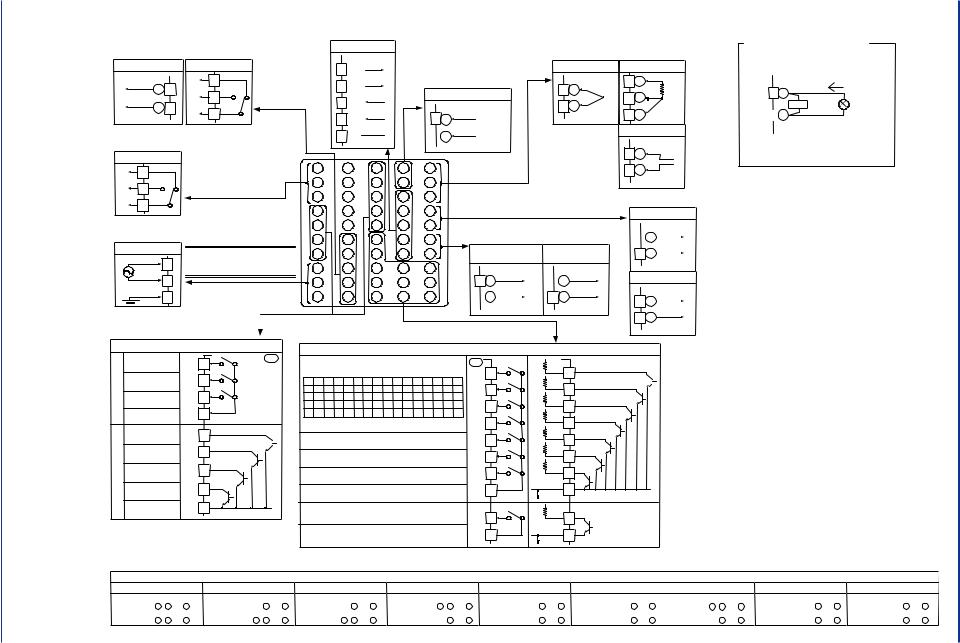
00-2006 31, May Edition: 3rd 46E-05E01C02 IM
■ UP550 Heating / Cooling Type (Model UP550-2 ), Heating / Cooling Loop Control with PV Switching
Cooling-side control |
Cooling-side control |
|
|||||
output |
|
|
output |
Note: Select this option from |
|||
|
|
|
|
|
|
||
Current/voltage pulse output |
Relay contact output |
the OT1 parameter. |
|||||
|
|
|
|
NC |
48 |
*Time proportional PID |
|
|
|
|
|
relay contact output is |
|||
|
|
+ |
46 |
|
|
||
|
0-20 mA DC |
|
49 |
configured at factory |
|||
|
|
|
NO |
||||
|
4-20 mA DC, |
|
|
before shipment. |
|
||
voltage pulse (12 V) |
- |
47 |
|
|
|
||
|
|
COM |
50 |
|
|
||
|
|
|
|
|
|
||
|
|
|
|
Contact rating: 250 V AC, 3 A |
|
||
|
|
|
|
|
30 V DC, 3 A (resistance load) |
|
|
Heating-side control output |
|
|
|||||
Relay contact output |
Note: Select this option from the |
|
|||||
|
OT1 parameter. |
|
|
||||
|
|
|
|
|
|
1 |
|
NC |
1 |
|
|
*Time proportional PID relay contact |
|||
|
|
|
|||||
|
2 |
|
|
output is configured at factory |
2 |
||
NO |
|
|
before shipment. |
|
3 |
||
|
|
|
|
|
|||
|
|
|
|
|
|
|
|
COM |
3 |
|
|
|
|
|
4 |
|
|
|
|
|
|
|
|
Contact rating: 250 V AC, 3 A |
|
|
5 |
||||
|
30 V DC, 3 A (resistance load) |
|
|||||
Power supply |
|
Power supply |
|
L |
8 |
|
|
N |
9 |
|
|
|
10 |
 CAUTION
CAUTION
Before carrying out wiring, turn off the power to the controller and check that cables to be connected are not alive with a tester or the like because there is a possibility of electric shock.
6 7 8 9 10
RS-485 communication |
|
23 SDB(+) |
|
24 SDA(-) |
|
25 RDB(+) |
|
26 RDA(-) |
|
27 |
SG |
41 |
31 |
42 |
32 |
43 |
33 |
44 |
34 |
45 |
35 |
46 |
36 |
47 |
37 |
48 |
38 |
49 |
39 |
50 |
40 |
*Wiring can only be carried out for controllers with communication functions.
Maximum baud rate: 9600 bps
|
|
PV input 2 |
|
Auxiliary input |
|
21 |
+ |
Specify in a range of |
|
|
|
|
|
1-5 V DC, 0-2 V DC, |
22 |
- |
or 0-10 V DC. |
|
||
|
|
Default: 1-5 V DC |
2111
2212
2313
2414
PV input 1 |
* Not configured at factory before shipment |
||
|
|
See "2. Initial Settings". |
|
|
TC input |
RTD input |
|
12 |
+ |
11 |
A |
|
b |
||
|
- |
12 |
|
13 |
|
|
|
|
|
|
|
|
|
13 |
B |
|
|
|
mV/V input |
|
|
12 |
+ |
|
|
13 |
- |
Receiving 4-20 mA DC Current |
||||
Signals with the Controller |
||||
* When receiving 4-20 mA DC current signals, |
||||
set the PV input type to 1-5 V DC (setpoint “41”). |
||||
12 |
+ |
|
|
|
|
|
|||
|
|
250 Ω 4-20mA |
||
|
|
- |
|
|
|
13 |
|
|
|
|
|
|
|
|
Note: Connecting a 250 Ω resistor to the terminals is |
||||
optional. |
||||
Model: X010-250-2 (resistor with M3.5 crimp-on terminal |
||||
lugs) |
|
|
|
|
Retransmission output 1* |
* Factory-set to “PV retransmission.” |
2515
2616
2717
2818
2919
3020
Heating-side |
Note: Select this option from the OT1 parameter. |
|
|
|
|
|
|
|||||||
* Retransmission output 2 is available |
|
|
|
|
|
|
||||||||
control output |
|
only when “relay” is selected as the |
|
14 |
+ |
|
|
|
||||||
|
type of control output. |
|
|
|
4-20 or |
|||||||||
Current/voltage |
|
Retransmission |
15 |
- |
|
0-20 mA DC |
||||||||
|
|
|
|
|||||||||||
|
pulse output |
|
|
|
output |
2* |
|
|
|
|||||
|
|
|
|
|
|
|
|
|
|
|||||
|
|
|
|
|
|
Default: Unspecified |
|
|
Default: 4-20 mA DC |
|||||
|
|
|
|
|
|
retransmission type |
15 |
V DC loop power supply* |
||||||
16 |
+ |
0-20mADC, |
|
|
16 |
+ |
0-20mADC, |
|
|
|
|
|
|
|
|
|
|
|
|
|
|
|
|
|
|
|
|||
|
|
4-20mADC |
|
|
|
|
|
|
|
|
|
|
||
|
|
|
|
|
|
4-20mADC |
|
|
|
|
|
|
||
17 |
- |
Voltage pulse (12 V) |
17 |
- |
|
|
|
|
|
|
||||
|
|
|
|
|
14 |
+ |
|
|
|
|||||
|
|
|
|
|
|
|
|
|
|
|
|
|||
Load resistance: 600 |
Ω or less |
*Retransmission output 1 is not available if a 15 V DC loop power supply is used.
Allowable range: 100-240 V AC ( 10%) (free voltage) 50/60 Hz shared |
Default: 4-20 mA DC |
14.5-18.0 V DC |
(21 mA DC max.) |
* The functions of a contact output can be varied |
15 |
- |
by changing the setting of the contact output |
* The functions of a contact input can be varied by changing the setting of the contact |
|
registration parameter. |
|
|
input registration parameter. |
|
|
|
|
|
External contact outputs |
||
|
PV event 1 output |
DO1 |
UP |
|
6 |
||
|
|
|
|
Relay |
PV event 2 output |
DO2 |
5 |
Instrument alarm |
DO3 |
4 |
|
|
|
||
|
1 output |
|
|
|
|
|
|
|
Common |
COM |
7 |
|
|
||
Transistor
Time event 1 output
Time event 2 output
Time event 3 output
Time event 4 output
Common
DO4 34 |
|
DO5 |
33 |
|
|
DO6 |
32 |
|
|
DO7 |
31 |
|
|
COM |
35 |
|
|
Relay contact rating: 240 V AC, 1 A 30 V DC, 1 A (resistance load) Transistor contact rating: 24 V DC, 50 mA
|
|
|
|
|
|
|
|
|
|
|
|
|
|
External contact inputs |
||||
Switch between the ON and OFF states of the DI1 to DI4 |
|
UP |
Contact |
|||||||||||||||
contact inputs to select from program pattern numbers |
1 to 15. |
|
||||||||||||||||
DI1 |
19 |
|||||||||||||||||
(Select a number during a RESET state.) |
|
|
|
|
|
|||||||||||||
|
1 |
2 |
3 |
4 |
5 |
6 |
7 |
8 |
9 |
10 |
11 |
12 |
13 |
14 |
15 |
|
|
|
DI1 ON OFF ON OFF ON |
OFF ON OFF ON OFF ON OFF ON |
OFF ON |
DI2 |
18 |
||||||||||||||
DI2 |
OFF ON ON OFF OFF ON ON OFF OFF ON ON OFF OFF ON ON |
|||||||||||||||||
|
|
|||||||||||||||||
DI3 |
OFF OFF OFF ON ON ON ON OFF OFF OFF OFF |
ON ON ON ON |
DI3 |
40 |
||||||||||||||
DI4 |
OFF OFF OFF OFF OFF OFF OFF ON ON ON ON ON ON ON ON |
|||||||||||||||||
|
||||||||||||||||||
|
|
|||||||||||||||||
|
|
|
|
|
|
|
|
|
|
|
|
|
|
|
|
DI4 |
39 |
|
|
|
|
|
|
|
|
|
|
|
|
|
|
|
|
|
|
||
|
|
|
Start of program operation when |
|
|
|
DI5 |
38 |
||||||||||
|
|
|
|
DI5 changes from OFF to ON |
|
|
|
|
||||||||||
|
|
|
|
|
|
|
|
|
|
|||||||||
|
|
|
Stop of program operation when |
|
|
|
DI6 |
37 |
||||||||||
|
|
|
|
DI6 changes from OFF to ON |
|
|
|
|
||||||||||
|
|
|
|
|
|
|
|
|
|
|||||||||
|
|
|
|
PV input 2 when DI7=ON |
|
|
|
|
DI7 |
36 |
||||||||
|
|
|
PV input 1 when DI7=OFF (NOTE) |
|
|
|
||||||||||||
|
|
|
|
|
|
|
|
|||||||||||
|
|
|
|
|
|
|
Common |
|
|
|
|
|
|
|
COM 20 |
|||
|
|
|
|
|
|
|
|
|
|
|
|
|
|
|
|
|||
|
ON when using 16 or more of program patterns |
|
DI8 |
28 |
||||||||||||||
|
|
|
|
|
|
|
|
|
|
|
|
|
|
|
|
|||
|
|
|
|
|
|
|
Common |
|
|
|
|
|
|
|
COM 30 |
|||
+5V |
DI1 |
Transistor contact |
|
|
19 |
||
+5V |
|
||
DI2 |
|
||
+5V |
18 |
||
|
|||
|
|
||
+5V |
DI3 |
40 |
|
|
|||
|
|
||
+5V |
DI4 |
39 |
|
|
|||
|
|
||
+5V |
DI5 |
38 |
|
|
|||
|
|
||
+5V |
DI6 |
37 |
|
|
|||
|
|
||
|
DI7 |
36 |
|
|
|
||
|
COM |
20 |
|
|
|
||
+5V |
|
NOTE: When operating paramter U3 set to "2", effective to contact input. |
|
DI8 |
|
||
|
28 |
||
|
|
||
|
COM |
30 |
|
|
|
* OT1 is a setup parameter. |
|
|
Contact rating: 12 V DC, 10 mA or more |
|
|
|
|
|
|
|
|
|
|
|
|
|
|
|
|
You can change the settings of the parameter OT1 to change the control output type. See "2. Initial Settings". |
|
|
|
|
|
|
|||
|
|
Correspondence between parameter OT1 and heating-side output types/cooling-side output types |
|
|
|||||
OT1=4 (factory-set default) |
OT1=5 |
OT1=6 |
OT1=7 |
OT1=8 |
OT1=9 |
|
OT1=10 |
|
|
Heating side: Relay output |
Heating side: Voltage pulse output |
Heating side: Current output |
Heating side: Relay output |
Heating side: Voltage pulse output |
Heating side: Current output |
|
Heating side: Relay output |
||
(terminals 1 , 2 and 3 ) |
(terminals 16 and 17 ) |
(terminals 16 and 17 ) |
(terminals 1 , 2 and 3 ) |
(terminals 16 and 17 ) |
(terminals 16 and 17 |
) |
(terminals 1 , |
2 and |
3 ) |
Cooling side: Relay output |
Cooling side: Relay output |
Cooling side: Relay output |
Cooling side: Voltage pulse output |
Cooling side: Voltage pulse output |
Cooling side: Voltage pulse output |
Cooling side: Current output |
|||
(terminals 48 , 49 and 50 ) |
(terminals 48 , 49 and 50 ) |
(terminals 48 , 49 and 50 ) |
(terminals 46 and 47 ) |
(terminals 46 and 47 ) |
(terminals 46 and 47 |
) |
(terminals |
46 and |
47 ) |
The types of control output, “relay output” and “voltage pulse output” shown in the table above refer to those of time proportional control. |
|
|
|
|
|
||||
To change to a relay output for on-off control, select “Relay Terminals” and change the setpoint of the proportional band to “0.” |
|
|
|
|
|
||||
OT1=11 |
|
Heating side: Voltage pulse output |
|
(terminals 16 |
and 17 ) |
Cooling side: Current output |
|
(terminals 46 |
and 47 ) |
OT1=12 |
|
Heating side: Current output |
|
(terminals |
16 and 17 ) |
Cooling side: Current output |
|
(terminals |
46 and 47 ) |
<Toc>
Installation> .<1
15-1
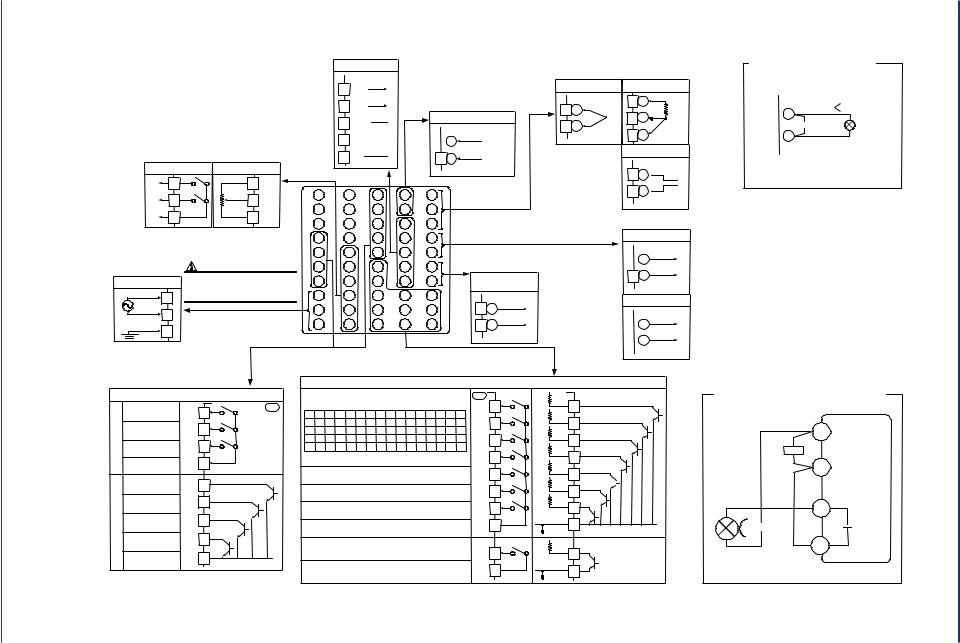
00-2006 31, May Edition: 3rd 46E-05E01C02 IM
■UP550 Position Proportional Type (Model UP550-1 ), Position Proportional Loop Control with PV Switching
|
Position proportional control output |
||||||
|
Relay contact output |
Feedback input |
|||||
|
|
H |
48 |
|
|
0% |
47 |
|
(Direct) |
|
|
|
|||
|
|
|
|
|
|
||
|
|
L |
49 |
|
|
|
46 |
|
(Reverse) |
|
|
|
|||
|
|
|
|
|
|
||
|
COM |
50 |
|
|
100% |
45 |
|
|
|
|
|
|
|
|
|
|
Contact rating: 250 V AC, 3 A |
Resistance: 100 to 2.5 k |
|||||
|
30 V DC, 3 A (resistance load) |
|
|
||||
Power supply |
|
|
CAUTION |
|
|||
|
Before carrying out wiring, turn off the power |
||||||
|
Power supply |
|
|||||
|
|
to the controller and check that cables to be |
|||||
|
L |
|
|
connected are not alive with a tester or the like |
|||
|
8 |
|
because there is a possibility of electric shock. |
||||
|
|
|
|||||
|
N |
9 |
|
|
|
|
|
|
|
|
|
|
|
|
|
|
|
10 |
|
|
|
|
|
Allowable range: 100-240 V AC ( 10%) |
|
||||||
|
|
(free voltage) |
|
|
|
||
|
|
50/60 Hz shared |
|
|
|||
* The functions of a contact output can be |
|
||||||
varied by changing the setting of the contact |
|
||||||
output registration parameter. |
|
|
|
||||
|
|
External contact outputs |
|
||||
|
PV event 1 output |
DO1 |
6 |
|
UP |
||
|
|
|
|||||
Relay |
PV event |
2 output |
DO2 |
5 |
|
|
|
Instrument alarm |
DO3 |
4 |
|
|
|||
|
1 output |
|
|
|
|
||
|
|
|
|
|
|
||
|
Common |
|
COM |
7 |
|
|
|
|
|
|
|
|
|||
Transistor
Time event 1 output
Time event 2 output
Time event 3 output
Time event 4 output
Common
DO4 34 |
|
DO5 |
33 |
|
|
DO6 |
32 |
|
|
DO7 |
31 |
|
|
COM |
35 |
|
|
Relay contact rating: 240 V AC, 1 A 30 V DC, 1 A (resistance load) Transistor contact rating: 24 V DC, 50 mA
RS-485 communication |
* Wiring can only be carried out |
|
for controllers with communication |
||
|
||
|
functions. |
|
23 SDB(+) |
Maximum baud rate: 9600 bps |
24 25 26 27
SDA(-)
RDB(+)
RDA(-) 
SG
|
|
PV input 2 |
|
Auxiliary input |
|
|
+ |
|
21 |
Specify in a range of |
|
|
|
|
|
|
1-5 V DC, 0-2 V DC, |
22 |
- |
or 0-10 V DC. |
|
||
|
|
Default: 1-5 V DC |
1 |
41 |
31 |
21 |
11 |
|
|
|
2 |
42 |
32 |
22 |
12 |
|
|
|
3 |
43 |
33 |
23 |
13 |
|
|
|
4 |
44 |
34 |
24 |
14 |
|
|
|
5 |
45 |
35 |
25 |
15 |
|
|
|
6 |
46 |
36 |
26 |
16 |
|
|
|
7 |
47 |
37 |
27 |
17 |
Retransmission |
||
|
output 2 |
||||||
8 |
48 |
38 |
28 |
18 |
|
||
|
Default: Unspecified |
||||||
|
|
|
|
|
|
retransmission type |
|
9 |
49 |
39 |
29 |
19 |
16 |
+ |
0-20mADC, |
|
|
||||||
|
|
|
|
|
|
|
|
10 |
50 |
40 |
30 |
20 |
17 |
- |
4-20mADC |
|
|||||||
|
|
|
|
|
|
Default: 4-20 mA DC |
|
PV input 1 |
* Not configured at factory before shipment |
||
|
|
See "2. Initial Settings". |
|
|
TC input |
RTD input |
|
12 |
+ |
11 |
A |
|
b |
||
|
- |
12 |
|
13 |
|
|
|
|
|
13 |
B |
|
|
mV/V input |
|
12+ 
13- 
Receiving 4-20 mA DC Current |
||||||
Signals with the Controller |
||||||
* When receiving 4-20 mA DC current signals, |
||||||
set the PV input type to 1-5 V DC (setpoint “41”). |
||||||
|
|
|
|
|
|
|
|
12 |
+ |
|
|
|
|
|
|
|
|
|
|
|
|
|
|
|
|
|
|
|
|
|
250 Ω |
4-20mA |
||
|
|
- |
|
|
|
|
|
13 |
|
|
|
|
|
Note: Connecting a 250 Ω resistor to the terminals is |
||||||
optional. |
||||||
Model: X010-250-2 (resistor with M3.5 crimp-on terminal |
||||||
lugs) |
|
|
|
|
|
|
Retransmission output 1 |
* PV retransmission is configured at factory |
|||||
|
|
|
|
|
before shipment. |
|
|
|
|
+ |
|
|
|
|
14 |
|
4-20 mA DC, |
|
|
|
|
|
|
|
|
|
|
15 |
- |
0-20 mA DC |
|
|
||
|
Load resistance: 600 |
Ω or less |
||||
|
|
|
||||
|
|
|
|
|
||
|
|
|
Default: 4-20 mA DC |
|
|
|
15 V DC loop power supply |
* If 15 V DC loop power supply is used, |
|||||
|
|
|
|
|
retransmission output 1 cannot be used. |
|
|
|
|
|
|
||
|
14 |
+ |
14.5-18.0VDC |
|
|
|
|
|
|
|
|
|
|
|
|
|
|
|
|
|
|
|
- |
(21 mA DC max.) |
|
|
|
|
15 |
|
|
|
||
* The functions of a contact input can be varied by changing the setting of the contact input registration parameter.
|
|
|
|
|
|
|
|
|
|
|
|
|
|
External contact inputs |
||||
Switch between the ON and OFF states of the DI1 to DI4 |
|
UP |
Contact |
|||||||||||||||
contact inputs to select from program pattern numbers |
1 to 15. |
|
||||||||||||||||
DI1 |
19 |
|||||||||||||||||
(Select a number during a RESET state.) |
|
|
|
|
|
|||||||||||||
|
1 |
2 |
3 |
4 |
5 |
6 |
7 |
8 |
9 |
10 |
11 |
12 |
13 |
14 |
15 |
|
|
|
DI1 ON OFF ON OFF ON |
OFF ON OFF ON OFF ON OFF ON |
OFF ON |
DI2 |
18 |
||||||||||||||
DI2 |
OFF ON ON OFF OFF ON ON OFF OFF ON ON OFF OFF ON ON |
|||||||||||||||||
|
|
|||||||||||||||||
DI3 |
OFF OFF OFF ON ON ON ON OFF OFF OFF OFF |
ON ON ON ON |
DI3 |
40 |
||||||||||||||
DI4 |
OFF OFF OFF OFF OFF OFF OFF ON ON ON ON ON ON ON ON |
|||||||||||||||||
|
||||||||||||||||||
|
|
|||||||||||||||||
|
|
|
|
|
|
|
|
|
|
|
|
|
|
|
|
DI4 |
39 |
|
|
|
|
|
|
|
|
|
|
|
|
|
|
|
|
|
|
||
|
|
|
Start of program operation when |
|
|
|
DI5 |
38 |
||||||||||
|
|
|
|
DI5 changes from OFF to ON |
|
|
|
|
||||||||||
|
|
|
|
|
|
|
|
|
|
|||||||||
|
|
|
Stop of program operation when |
|
|
|
DI6 |
37 |
||||||||||
|
|
|
|
DI6 changes from OFF to ON |
|
|
|
|
||||||||||
|
|
|
|
|
|
|
|
|
|
|||||||||
|
|
|
|
PV input 2 when DI7=ON |
|
|
|
|
DI7 |
36 |
||||||||
|
|
|
PV input 1 when DI7=OFF (NOTE) |
|
|
|
||||||||||||
|
|
|
|
|
|
|
|
|||||||||||
|
|
|
|
|
|
|
Common |
|
|
|
|
|
|
|
COM 20 |
|||
|
|
|
|
|
|
|
|
|
|
|
|
|
|
|
|
|||
|
ON when using 16 or more of program patterns |
|
DI8 |
28 |
||||||||||||||
|
|
|
|
|
|
|
|
|
|
|
|
|
|
|
|
|||
|
|
|
|
|
|
|
Common |
|
|
|
|
|
|
|
COM 30 |
|||
+5V |
DI1 |
|
|
|
19 |
||
+5V |
|
||
DI2 |
|
||
+5V |
18 |
||
|
|||
|
|
||
+5V |
DI3 |
40 |
|
|
|||
|
|
||
+5V |
DI4 |
39 |
|
|
|||
|
|
||
+5V |
DI5 |
38 |
|
|
|||
+5V |
DI6 |
37 |
|
|
|||
|
DI7 |
36 |
|
|
|
||
|
COM |
20 |
|
|
|
||
+5V |
DI8 |
|
|
|
28 |
||
|
|
||
|
COM |
30 |
|
|
|
Transistor contact
Contact rating: 12 V DC, 10 mA or more NOTE: When operating paramter U3 set to "2", effective to contact input.
*The following method of wiring is only possible when the controller is equipped with a 24 V DC loop power supply.
24 V DC Power Supply Wired to Sensor in Two-wire System Configuration
|
|
12 |
|
External |
|
PV input |
|
resistor |
250 |
||
1-5 V DC |
|||
(Note) |
|
||
|
signal |
||
|
|
||
|
|
13 |
|
Two-wire |
|
|
|
transmitter |
|
43 |
|
|
|
||
|
|
Loop power |
|
4-20mADC |
|
supply |
|
|
21.6- |
||
|
|
||
|
|
28.0 V DC |
|
|
|
44 |
|
Note: Connecting a 250 resistor to the terminals is optional. |
|||
Model: X010-250-2 (resistor with M3.5 crimp-on terminal lugs) |
|||
<Toc>
Installation> .<1
16-1
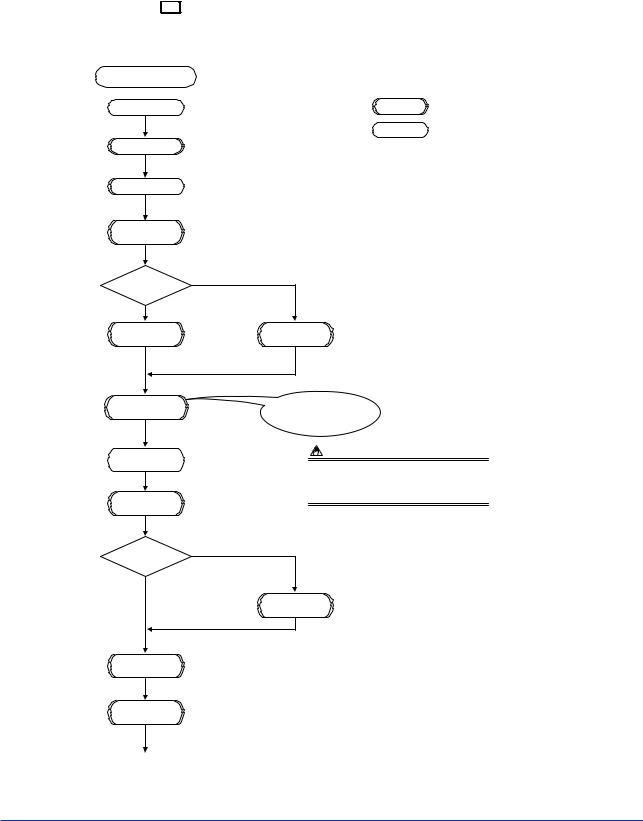
<Toc> |
<2. Initial Settings> |
2-1 |
2.Initial Settings
This chapter describes examples of setting PV input types, control output types. Carrying out settings described herein allows you to perform basic control. Refer to examples of various settings to understand how to set parameters required. Refer to “6.1 Parameter Map” for an easy to understand explanation of setting various parameters. If you cannot remember how to carry out an operation during setting, press the DISP key no more than four times. This brings you to the display (operating display) that appears at power-on. After carrying out the settings described here, create programs in “3. Programming.”
Setup Procedure
Power-on |
Denotes a step that must always be followed. |
Denotes a step that should be followed as necessary.
Set UP mode “6” (Factory-set to Single-loop Control “UP mode 1.”)
See “2.2 Setting UP mode (Setting First at Power-on)” or “2.3 Changing UP mode.”
Set PV input  (Factory-set to ; PV input 1 is “not configured”, PV input 2 is “standard signal (1-5 V DC).”)
(Factory-set to ; PV input 1 is “not configured”, PV input 2 is “standard signal (1-5 V DC).”)
See “2.4 Setting PV Input 1 and PV Input 2 Types.”
Set Controlled PV
Input Range |
|
|
|
|
See “2.5 |
Setting Controlled PV Input Range.” |
|||
Position |
No |
|
|
|
proportional |
|
|
|
|
controller? |
|
|
|
|
Yes |
|
|
|
|
Calibrate valve |
|
Set the control |
||
position. |
|
output. |
(Factory-set to “Time Proportional Relay Output.”) |
|
|
|
|||
See “2.7 |
|
See “2.6 Setting Control Output Type.” |
||
Calibrating Valve Position.” |
|
|||
Initialize |
|
Be sure to follow this |
||
step whenever a chang of setting |
||||
parameters. |
||||
|
is made to the UP mode or |
|||
|
|
|||
See “2.8 |
Initializing Parameters.” |
PV input type. |
||
|
|
|||
Set setup |
|
|
NOTE |
|
parameters. |
|
|
When initializing parameters is excuted, the controller initializes |
|
|
|
|
the operating parameter and setup parameters. Therefore, check |
|
|
|
|
that the appropriate value are set for the parameters after |
|
|
|
|
initializing parameters. If changed to initial values, set them to the |
|
Set PV Switching |
|
|
appropriate values again. |
|
|
|
|
||
Methods |
|
|
|
|
See “2.9 |
Setting PV Switching Methods.” |
|
||
Switching |
No |
|
|
|
input with contact |
|
|
|
|
input |
|
|
|
|
Yes |
|
|
|
|
Set Input Switching
PV Range
See “2.10 Setting Input Switching PV Range.”
Set operating parameters.
Set program patterns.
See “3. Programming.”
Controller operation
IM 05E01C02-46E 3rd Edition: May 31, 2006-00
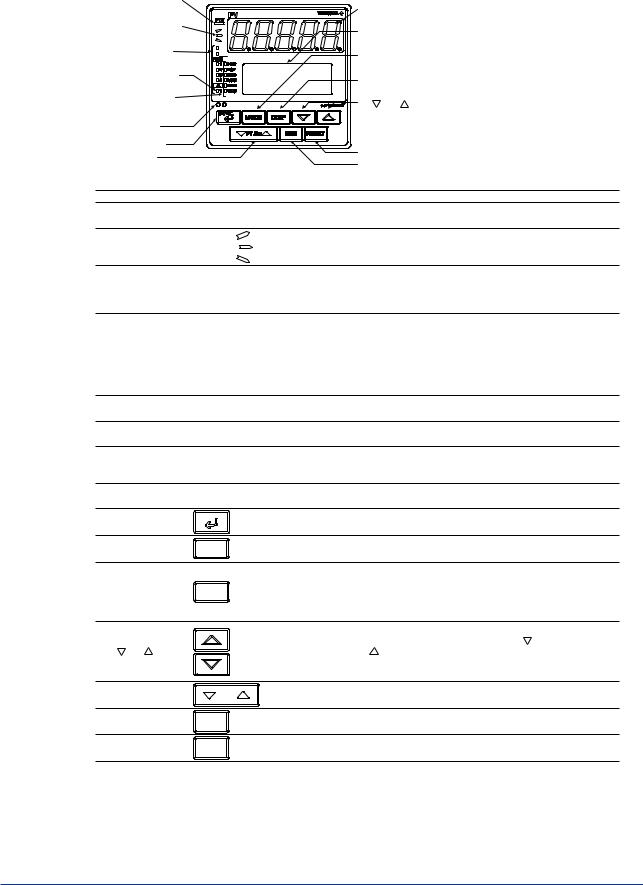
<Toc> |
<2. Initial Settings> |
2-2 |
2.1Names and Functions of Front Panel Parts
1.Indicator lamp for PV2 display
6.Process
2. Program monitor |
|
|
variable (PV) display |
||
lamps |
|
7. Setpoint |
|||
3. Event indicator |
PVE1 |
|
display |
||
lamps |
PVE2 |
10. MODE key |
|||
|
|
|
|||
8. Instrument alarm |
|
|
|
||
indicator lamp |
|
11. DISP key |
|||
4. Status indicator |
|
12. |
and keys |
||
lamps |
|
||||
5. Light-loader |
|
|
|
||
interface |
|
|
|
||
9. SET/ENT key |
|
15. RESET key |
|||
13. PT.No key |
|
||||
|
14. RUN key |
||||
|
|
|
|||
|
Name of Part |
|
|
Function |
|
1. |
Indicator lamp for |
|
Is lit when secondary PV is displayed on PV display. |
||
PV2 display |
|
Not used in loop control with PV switching. |
|||
|
|
||||
|
|
|
: Is lit (in green) when a program setpoint is increasing. |
||
2. |
Program monitor lamps |
: Is lit (in green) when a program setpoint is constant. |
|||
|
|
|
: Is lit (in green) when a program setpoint is decreasing. |
||
|
|
|
Display the statuses of PV events, time events and instrument alarms in orange. |
||
3. |
Event indicator lamps |
PVE1 and PVE2 lamps: Come on when PV event 1 and PV event 2 turn on. |
|||
TME1 to TME4 lamps: Come on when time event 1 to time event 4 turn on. |
|||||
|
|
|
|||
|
|
|
AL1 lamp: Comes on when instrument alarm 1 turns on. |
||
|
|
|
Is lit (in green) to indicate the status of operation or control. |
||
|
|
|
PRG:Is lit when in program mode. |
||
|
Status indicator |
|
RST:Is lit when in reset mode. |
|
|
4. |
|
HLD:Is lit when in hold mode. |
|
||
lamps |
|
|
|||
|
|
LOC:Is lit when in local mode. |
|
||
|
|
|
|
||
|
|
|
MAN:Is lit when in manual mode. |
||
|
|
|
CAS:Not used in loop control with PV switching. |
||
5. |
Light-loader interface |
Interface for an adapter cable used when setting and storing parameters from a PC. |
|||
This requires an optional parameter setting tool. |
|||||
|
|
|
|||
6. |
Process variable (PV) |
Displays PV. |
|
||
display |
|
Displays an error code (in red) if an error occurs. |
|||
|
|
||||
|
|
|
Displays the name and value of a program setpoint (SP), output (OUT), deviation trend, valve |
||
7. |
Setpoint display (LCD) |
opening, or a parameter. |
|
||
|
|
|
Displays an error code if an error occurs. |
||
8. |
Instrument alarm |
|
The AL1 lamp comes on in orange if instrument alarm 1 occurs. |
||
indicator lamp |
|
|
|
||
|
|
Used to switch or register a parameter. Pressing the key for more than 3 seconds allows you to switch |
|||
9. |
SET/ENT key |
S E T / E N T |
|||
|
between the operating display and the main menu for operating parameter setting display alternately. |
||||
|
|
|
|||
10. |
MODE key |
MODE |
Presents a display for switching between the hold, advance, local, AUTO and MAN modes. |
||
|
|
||||
|
|
|
Used to switch between displays. Pressing this key while any operating display is shown |
||
|
|
|
lets you switch to another prearranged operating display. Pressing this key while any |
||
11. |
DISP key |
DISP |
display other than an operating display is shown lets you go one display back. |
||
|
|
|
(One to four presses (maximum) of this key lets you return to the current operating display, |
||
|
|
|
though the number of presses depends on the operating status.) |
||
|
|
|
Used to change numerical values. On setting displays for various parameters, you can change target |
||
|
|
|
setpoints, parameters, and output values (in manual operation). Pressing the key decreases a |
||
12. |
and keys |
|
numerical value, while pressing the |
key causes it to increase. You can hold down a key to gradually |
|
|
|
|
increase the speed of change. These keys also switch between menu displays when a main menu or |
||
|
|
|
submenu of parameter setting display is shown. |
||
13. |
PT.No key |
|
Use this key when the controller is at a reset to select a program pattern number on |
||
PT.No |
|
||||
|
|
|
an operating display. |
|
|
14. |
RUN key |
RUN |
Pressing this key for more than 2 seconds while an operating display is shown starts the |
||
controller. |
|
||||
|
|
|
|
||
15. |
RESET key |
RESET |
Pressing this key for more than 2 seconds while an operating display is shown stops the |
||
controller. |
|
||||
|
|
|
|
||
IM 05E01C02-46E 3rd Edition: May 31, 2006-00
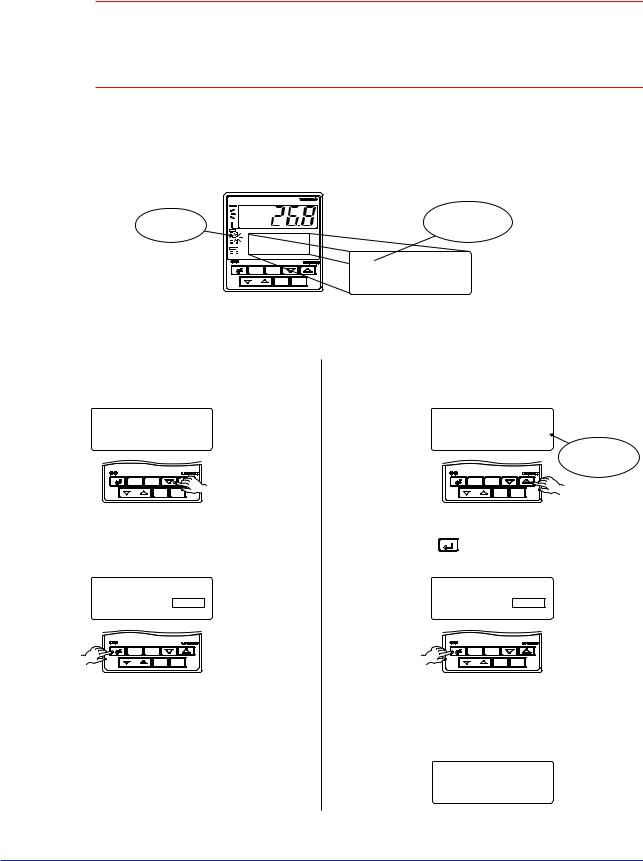
<Toc> |
<2. Initial Settings> |
2-3 |
2.2Setting UP mode (Setting First at Power-on)
 NOTE
NOTE
The controller displays an operating display when the power is turned on. The submenu “IN” appears at this point if the type of PV input has not been defined yet.
In this case, set a UP mode to “Loop Control with PV Switching,” following the operating procedure described below. Then, set PV input type, control output type and others.
The following operation describes a procedure of setting a UP mode to “Loop Control with PV Switching.” (set “6”)
1. Display view at power on
RST lamp ON.
PV2 PV
PVE1
PVE2
TME

 1
1  PRG
PRG

 2
2 
 RST
RST

 3
3 
 HLD
HLD
 4
4 
 LOC AL
LOC AL 

 MAN
MAN 
 1
1 
 CAS
CAS
SET/ENT
MODE DISP
 PT.No
PT.No RUN RESET
RUN RESET
Displays submenu “IN”.
IN
input set
SETUP sub menu
In steps 2 and later, illustrations of the LCD are cited to explain the procedure.
2. Press the  key once to display the submenu “MD”.
key once to display the submenu “MD”.
MD
UP mode set
SETUP sub menu
SET/ENT
MODE DISP
 PT.No
PT.No RUN RESET
RUN RESET
3. Press the  key once to display the parameter “UPM” (controller mode).
key once to display the parameter “UPM” (controller mode).
MENU:UPMD/MD |
#1 |
|
UP mode select |
|
|
|
|
SETUP |
UPM = |
|
1 |
SET/ENT |
DISP |
|
MODE |
|
|
PT.No |
RUN |
RESET |
4. Press the  or
or  key to display the setpoint “6”.
key to display the setpoint “6”.
MENU:UPMD/MD |
#1 |
UP mode select |
|
|
changing! |
UPM = |
6 |
Blinks during change.
SET/ENT
MODE DISP
 PT.No
PT.No RUN RESET
RUN RESET
5. Press the SET/ENT |
key once to register the |
|
setpoint “6”. |
|
|
MENU:UPMD/MD |
#1 |
|
UP mode select |
|
|
|
|
SETUP |
UPM |
= |
6 |
SET/ENT
MODE DISP
 PT.No
PT.No RUN RESET
RUN RESET
6. The controller re-starts (which is normal). Then, set PV input type. See “2.4 Setting PV Input 1 and PV Input 2 Types.”
IN
input set
SETUP sub menu
IM 05E01C02-46E 3rd Edition: May 31, 2006-00
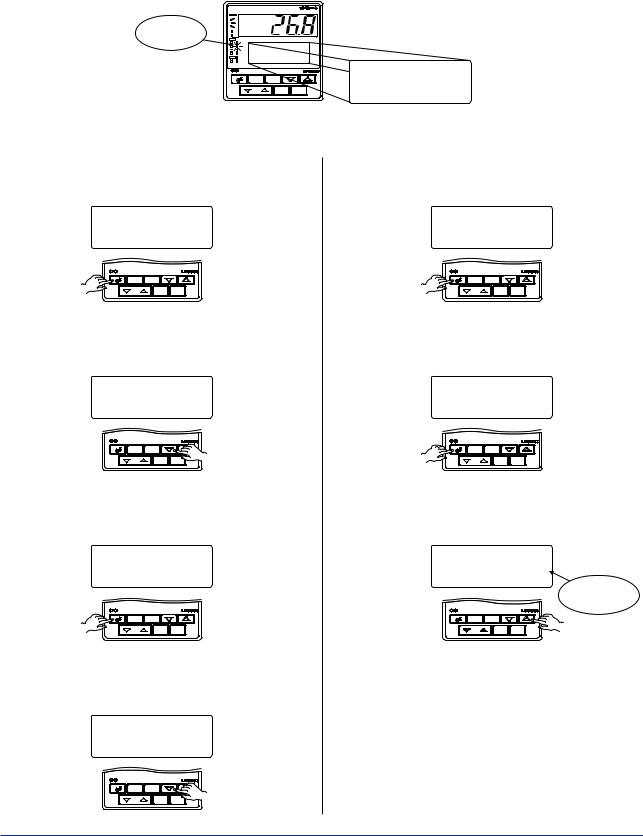
<Toc> |
<2. Initial Settings> |
2-4 |
2.3Changing UP mode
The following operation describes a procedure of changing a UP mode to “Loop Control with PV Switching.” (set “6”)
1. Bring the operating display into view (display appears at power-on).
|
PV2 |
PV |
RST lamp |
PVE1 |
|
ON. |
PVE2 |
RST |
2 |
||
|
TME |
|
|
1 |
PRG |

 3
3 
 HLD
HLD
4 |
LOC |
|
AL |
MAN |
|
1 |
CAS |
SP: -270.0°C |
SET/ENT MODE DISP |
||
 PT.No
PT.No RUN RESET
RUN RESET
PTNO: 0 |
SEGNO: 0/ 0 |
TM=------- |
RCY: 0/ 0 |
In steps 2 and later, illustrations of the LCD are cited to explain the procedure.
2. Press the  key for more than 3 seconds to call up the main menu “PROG”.
key for more than 3 seconds to call up the main menu “PROG”.
PROG
programming
main menu
SET/ENT
MODE DISP
 PT.No
PT.No RUN RESET
RUN RESET
3. Press the  key once to display the main menu “STUP”.
key once to display the main menu “STUP”.
STUP
password input
main menu
SET/ENT
MODE DISP
 PT.No
PT.No RUN RESET
RUN RESET
4. Press the  key once to display the main menu “PARA”.
key once to display the main menu “PARA”.
PARA
setup parameter SETUP main menu
SET/ENT
MODE DISP
 PT.No
PT.No RUN RESET
RUN RESET
5. Press the  key once to display the main menu “UPMD”.
key once to display the main menu “UPMD”.
UPMD
UP550 configuration
SETUP main menu
SET/ENT
MODE DISP
 PT.No
PT.No RUN RESET
RUN RESET
6. Press the  key once to display the submenu “MD”.
key once to display the submenu “MD”.
MD
UP mode set
SETUP sub menu
SET/ENT
MODE DISP
 PT.No
PT.No RUN RESET
RUN RESET
7. Press the  key once to display the parameter “UPM”.
key once to display the parameter “UPM”.
MENU:UPMD/MD |
#1 |
||
UP mode select |
|
|
|
|
|
SETUP |
|
UPM = |
1 |
|
|
SET/ENT
MODE DISP
 PT.No
PT.No RUN RESET
RUN RESET
8. Press the  or
or  key to display the setpoint “6”.
key to display the setpoint “6”.
MENU:UPMD/MD |
#1 |
|
UP mode select |
|
|
|
|
changing! |
UPM = |
|
6 |
|
|
Blinks during |
|
|
change. |
SET/ENT |
DISP |
|
MODE |
|
|
PT.No |
RUN |
RESET |
IM 05E01C02-46E 3rd Edition: May 31, 2006-00
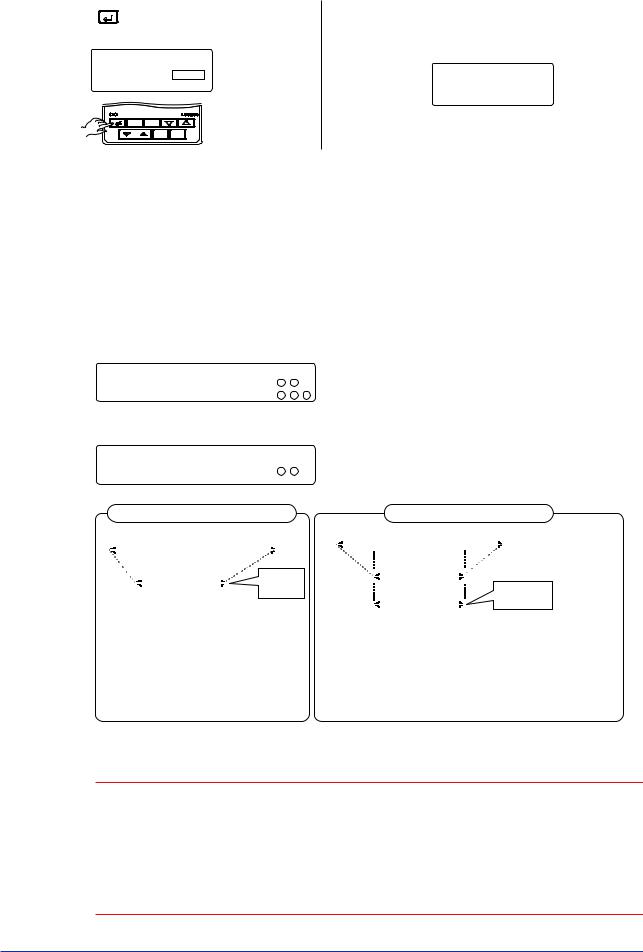
<Toc> |
<2. Initial Settings> |
2-5 |
9. Press the SET/ENT |
key once to register the |
||
setpoint. |
|
|
|
MENU:UPMD/MD |
#1 |
||
UP mode select |
|
||
|
|
|
SETUP |
UPM |
= |
|
6 |
SET/ENT |
MODE |
DISP |
|
|
|
||
|
PT.No |
RUN |
RESET |
10. The controller re-starts (which is normal). Then, set PV input type. See “2.4 Setting PV Input 1 and PV Input 2 Types.”
IN
input set
SETUP sub menu
2.4Setting PV Input 1 and PV Input 2 Types
The following operating procedure describes an example of setting the PV input 1 type to a K-type thermocouple (-200.0 to 500.0 C) and a measurement range of 0.0 to 200.0 C.
You can take the same steps for PV input 2 type (IN3) and scale (SH3, SL3) that are displayed after the PV input 1 related parameters.
PV input 1 (Factory-shipped setting: Not configured)
PV input terminal |
|
Thermocouple/mV/V input.............................. |
12 - 13 |
RTD input .................................................. |
11 - 12 - 13 |
PV input 2 (Factory-shipped setting: 1 to 5 V DC)
PV input terminal |
|
mV/V input.................................................... |
21 - 22 |
Example of Temperature Input
-270.0°C |
|
|
|
|
1370.0°C |
||||||
|
|
|
|
|
|
Instrument |
|
|
|
|
|
|
|
|
|
|
|
|
|
|
|
||
|
|
|
|
|
|
input range |
|
|
|
|
|
|
|
|
|
|
|
|
|
|
|
Set a range |
|
|
|
|
|
PV input range |
|
|
|
to be |
|||
|
|
|
|
|
|
|
|||||
|
|
|
|
|
|
|
|
|
|
controlled |
|
|
|
0.0°C |
|
800.0°C |
|||||||
|
|
|
|
|
|||||||
Minimum value of |
Maximum value of |
|
|
||||||||
PV input range (RL1) |
PV input range (RH1) |
|
|
||||||||
Parameters to be set for temperature input
1.PV input type (IN1): Set according to a sensor
2.Maximum value of PV input range (RH1): Set the maximum value of the range to be controlled.
3.Minimum value of PV input range (RL1): Set the minimum value of the range to be controlled.
Example of Voltage Input
1V |
2V |
|
|
4V |
5V (input signal) |
|||||||
|
|
|
|
|
|
Instrument |
|
|
|
|
||
|
|
|
|
|
|
input range |
|
|
|
|
|
|
|
|
|
|
|
|
|
|
|
|
|
||
|
|
|
|
|
|
|
|
|
|
|
|
|
|
|
RL1 |
|
|
PV input range |
|
|
RH1 |
||||
|
|
|
|
|
|
|||||||
|
|
|
|
|
|
|
|
|
|
|
Set a range to |
|
|
|
|
|
|
PV input scale |
|
|
be controlled |
||||
|
|
|
|
|
|
|
|
|
||||
|
|
0.0m3/h |
|
50.0m3/h |
||||||||
|
Minimum value of |
Maximum value of |
||||||||||
PV input scale (SL1) |
PV input scale (SH1) |
|||||||||||
Parameters to be set for voltage input
1.PV input type (IN1): Set according to an input signal
2.Maximum value of PV input range (RH1): Set the maximum value of an input signal.
3.Minimum value of PV input range (RL1): Set the minimum value of an input signal.
4.Position of PV input decimal point (SDP1): Set the position of the decimal point for PV input display.
5.Maximum value of PV input scale (SH1): Set the maximum value of the scale to be controlled.
6.Minimum value of PV input scale (SL1): Set the minimum value of the scale to be controlled.
 NOTE
NOTE
The controller may automatically initialize the registered operating parameter setpoints if any change is made to the data item PV Input Type (IN1), Maximum Value of PV Input Range (RH1), Minimum Value of PV Input Range (RL1), PV Input Decimal Point Position (SDP1), Maximum Value of PV Input Scale (SH1) or Minimum Value of PV Input Scale (SL1). After a change has been made to any of these data items, be sure to verify the registered operating parameter setpoints to ensure that they are correct. If any data item has been changed to its default, set it to a required value.
IM 05E01C02-46E 3rd Edition: May 31, 2006-00
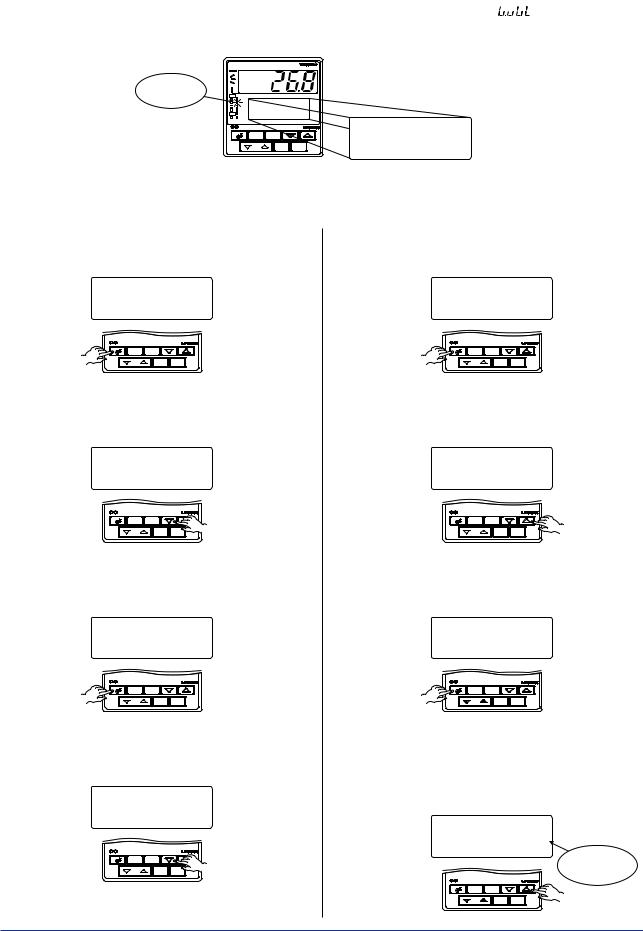
<Toc> |
<2. Initial Settings> |
2-6 |
1. Bring the operating display into view (display appears at power-on).
The PV display in the figure below shows the error code for input burnout (
 ) if PV input wiring is not yet complete. The error code disappears when you wire the PV input terminals correctly.
) if PV input wiring is not yet complete. The error code disappears when you wire the PV input terminals correctly.
|
PV2 |
PV |
RST lamp |
PVE2 |
|
ON. |
PVE1 |
|
2 |
RST |
|
|
TME |
|
|
1 |
PRG |

 3
3 
 HLD
HLD
4 |
LOC |
|
AL |
MAN |
|
1 |
CAS |
SP: -270.0°C |
SET/ENT MODE DISP |
||
 PT.No
PT.No RUN RESET
RUN RESET
PTNO: 0 |
SEGNO: 0/ 0 |
TM=------- |
RCY: 0/ 0 |
In steps 2 and later, illustrations of the LCD are cited to explain the procedure.
2. Press the  key for more than 3 seconds to call up the main menu “PROG”.
key for more than 3 seconds to call up the main menu “PROG”.
PROG
programming
main menu
SET/ENT
MODE DISP
 PT.No
PT.No RUN RESET
RUN RESET
3. Press the  key once to display the main menu “STUP”.
key once to display the main menu “STUP”.
STUP
password input
main menu
SET/ENT
MODE DISP
 PT.No
PT.No RUN RESET
RUN RESET
4. Press the  key once to display the main menu “PARA”.
key once to display the main menu “PARA”.
PARA
setup parameter SETUP main menu
SET/ENT
MODE DISP
 PT.No
PT.No RUN RESET
RUN RESET
5. Press the  key once to display the main menu “UPMD”.
key once to display the main menu “UPMD”.
UPMD
UP550 configuration
SETUP main menu
SET/ENT
MODE DISP
 PT.No
PT.No RUN RESET
RUN RESET
6. Press the  key once to display the submenu “MD”.
key once to display the submenu “MD”.
MD
UP mode set
SETUP sub menu
SET/ENT
MODE DISP
 PT.No
PT.No RUN RESET
RUN RESET
7. Press the  key once to display the submenu “IN”.
key once to display the submenu “IN”.
IN
input set
SETUP sub menu
SET/ENT
MODE DISP
 PT.No
PT.No RUN RESET
RUN RESET
8. Press the  key once to display the parameter “IN1” (PV input 1 type).
key once to display the parameter “IN1” (PV input 1 type).
MENU:UPMD/IN |
#1 |
||
input 1 type select |
|
|
|
|
|
SETUP |
|
IN1 = |
OFF |
||
SET/ENT |
DISP |
MODE |
|
PT.No |
RUN RESET |
9. Press the  or
or  key to display the required setpoint. The figure below shows an example of setting the PV input type to a K-type thermocouple (-200.0 C to 500.0 C).
key to display the required setpoint. The figure below shows an example of setting the PV input type to a K-type thermocouple (-200.0 C to 500.0 C).
MENU:UPMD/IN |
#1 |
||
input 1 type select |
|
||
|
|
|
changing! |
IN1 |
= |
typeK3 |
|
|
|
|
Blinks during |
|
|
|
change. |
|
SET/ENT |
DISP |
|
|
MODE |
|
|
|
PT.No |
RUN |
RESET |
IM 05E01C02-46E 3rd Edition: May 31, 2006-00
